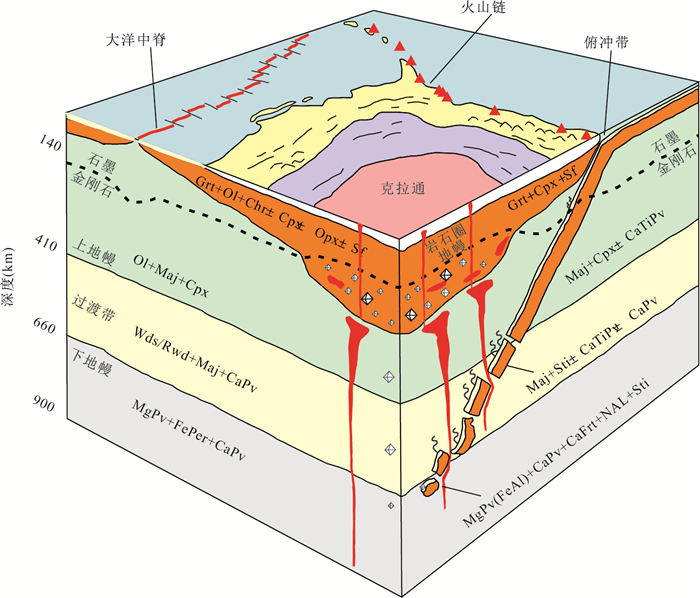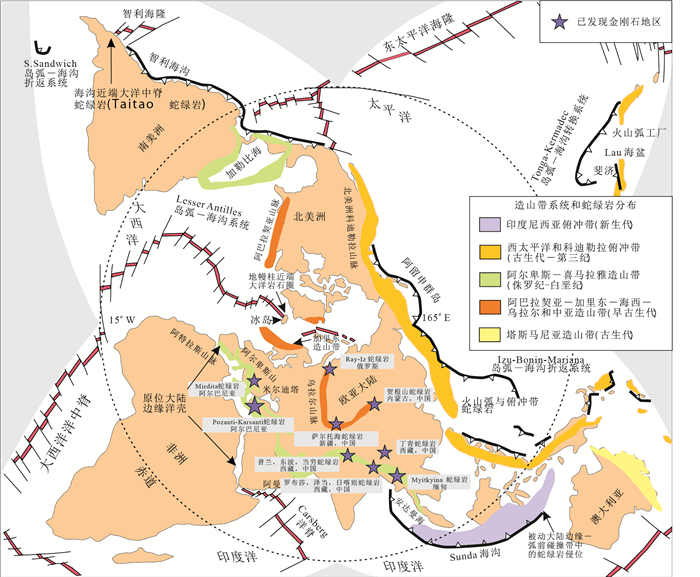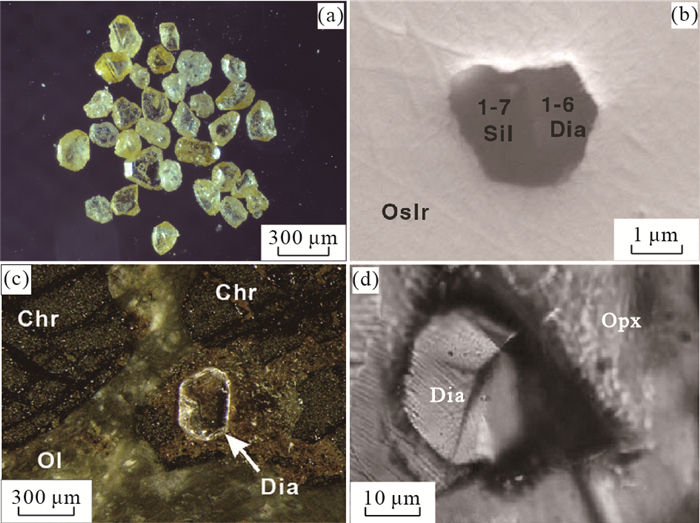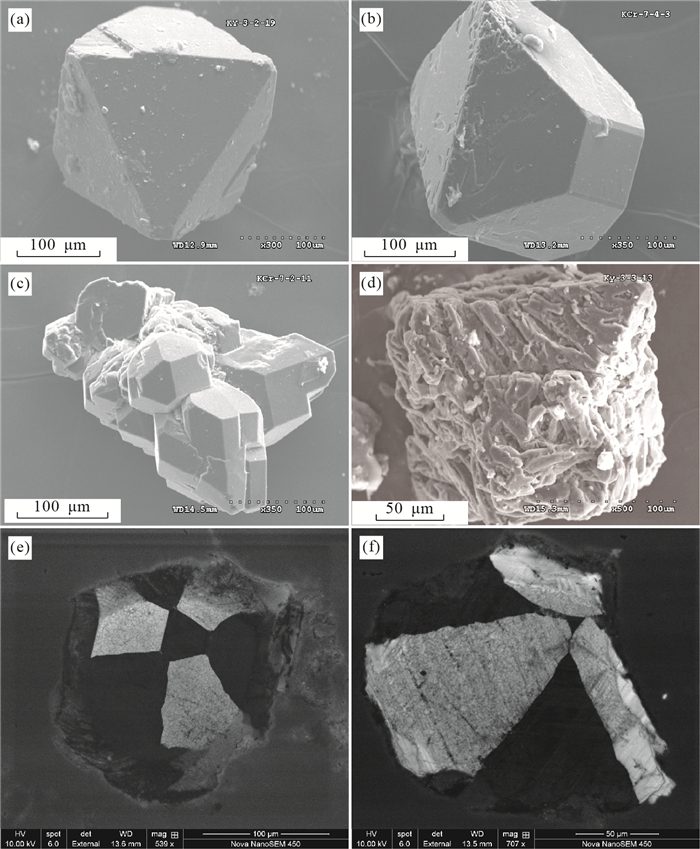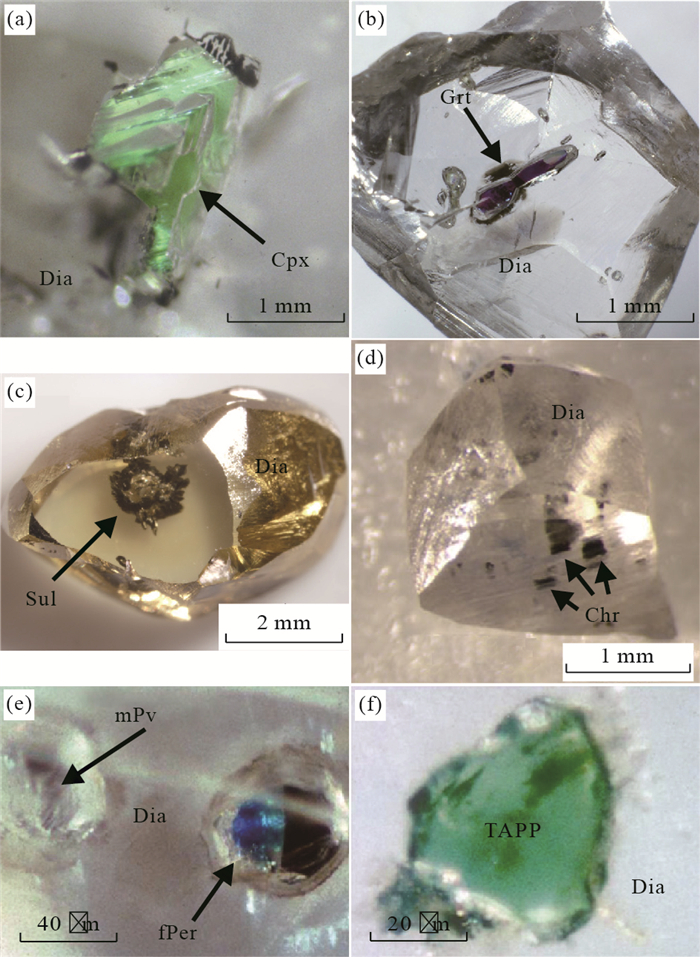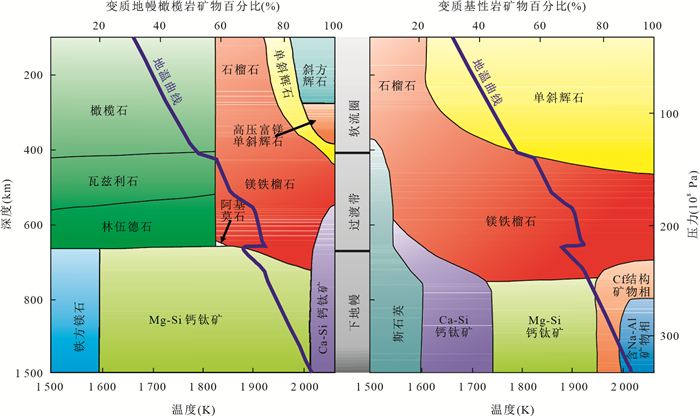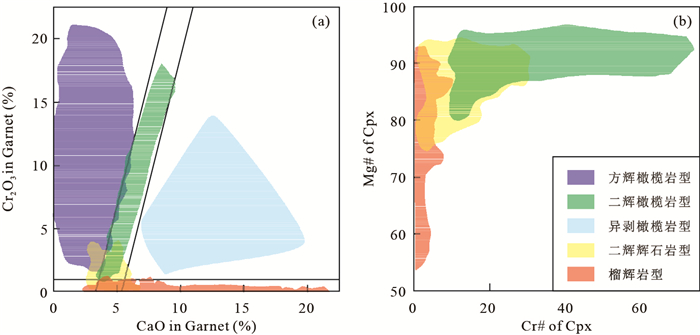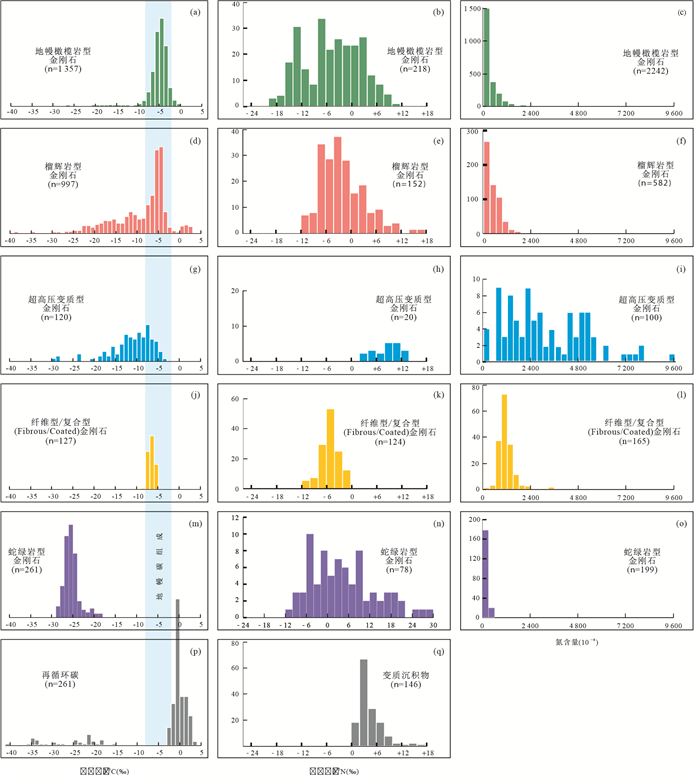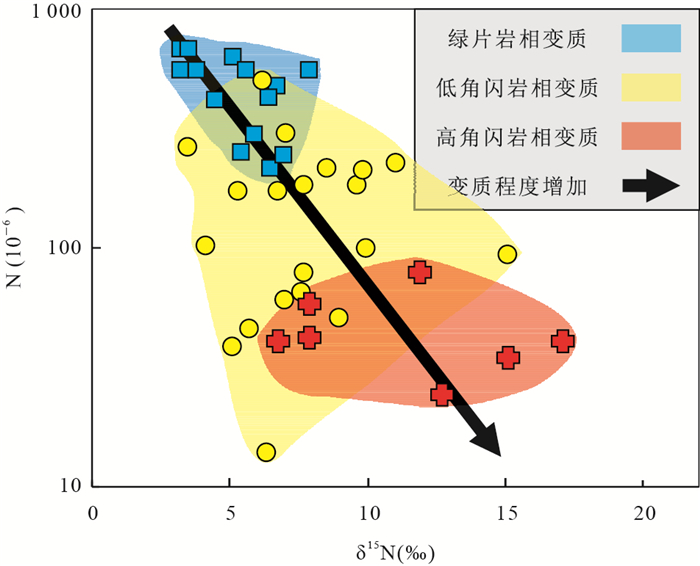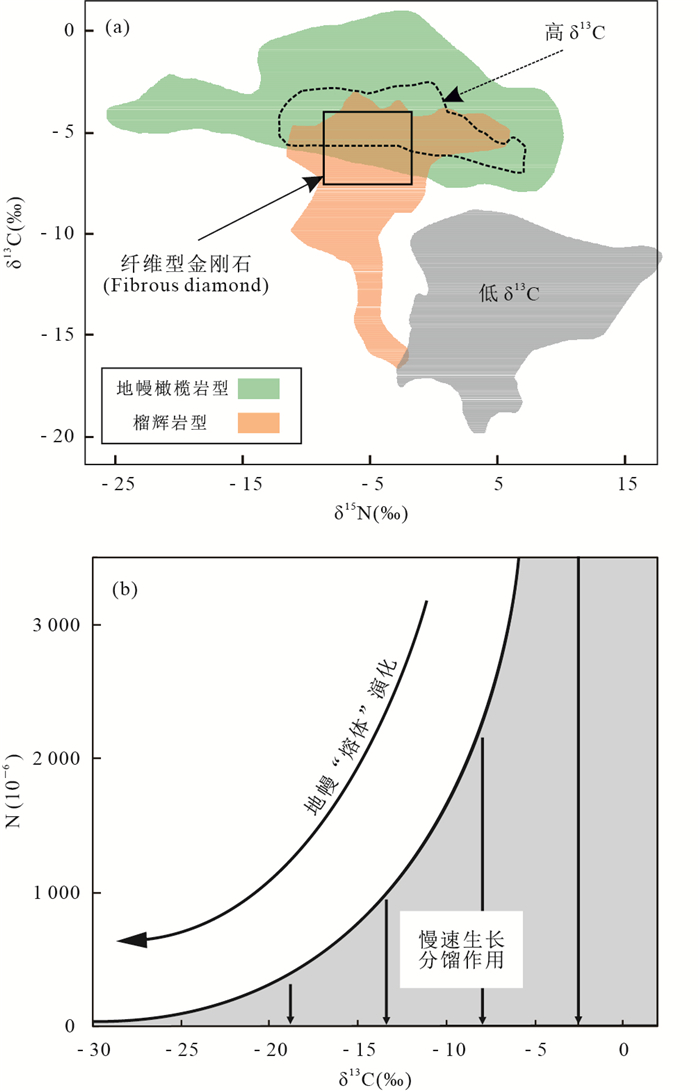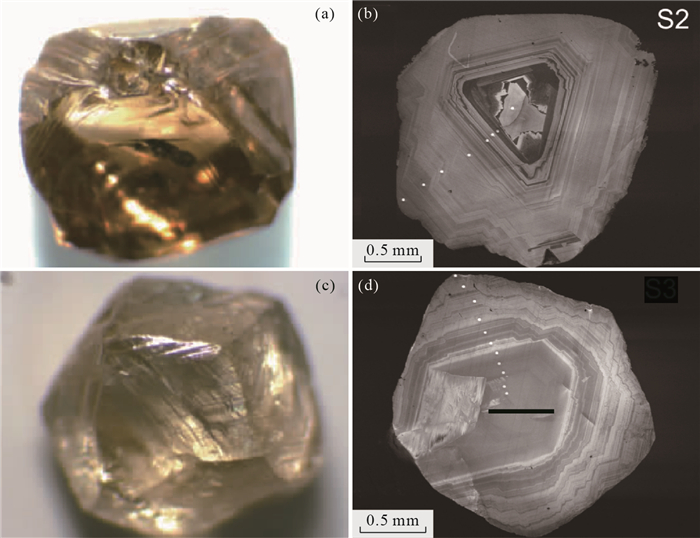Diamond Classification, Compositional Characteristics, and Research Progress: A Review
-
摘要: 金刚石由于其独特的物理化学性质,在经济生产与科学研究中均具有重要价值.金刚石形成于地球大于150 km的深度范围内,是人类可以获得的来自地球深部地幔乃至核幔边界的最直接的样品,因此可以为研究地球深部物质组成和物理化学条件提供重要的素材.金刚石由碳元素组成,还含有微量的杂质元素(如氮、硼、氢、氧等),其中氮和硼元素对于划分金刚石的晶体结构类型发挥着重要的作用.根据金刚石的产出类型,金刚石可以划分为幔源型、超高压变质型、陨石相关型以及蛇绿岩型金刚石.全球约百分之一的幔源型金刚石含有包裹体,对这些包裹体的研究显示,金刚石主要来源于地球150~200 km深度的岩石圈地幔.这些含有包裹体的金刚石中,仅有1%的金刚石来自于地球深部的软流圈、地幔过渡带、下地幔、甚至核幔边界.我国的金刚石产出类型多样,但是,目前仅山东蒙阴、辽宁复县的金伯利岩矿床以及湖南沅水的砂矿具有经济价值.蛇绿岩型金刚石是近年来金刚石研究领域取得的重要进展,该类型金刚石分布在全球多个造山带不同时代、不同构造属性的蛇绿岩地幔橄榄岩和铬铁矿中,被认为是一种新的金刚石的产出类型.相对于其他国家和地区的金刚石的研究,我国的金刚石领域的研究程度相对较低,缺乏对金刚石结构、化学组成以及包裹体组成的系统研究,制约了对我国金刚石成因的认识,限制了我国的金刚石的找矿工作.因此,亟需结合先进的分析手段对我国的金刚石及其围岩做进一步的研究,以期揭示金刚石的形成过程,为金刚石的找矿提供理论基础.Abstract: Due to the unique physicochemical characteristics, diamonds are of great significance in economic production and scientific research. Diamonds record valuable information about the physicochemical conditions and compositions of Earth's deep mantle and even the core-mantle boundary. Diamond mainly consists of carbon, with minor impurities such as nitrogen, boron and hydrogen. Of these impurities, nitrogen and boron play important roles in the classification of diamonds. Carbon and nitrogen are vital elements for life, the cycles of which are closely related to the environment that humans live in. Diamonds can provide clues for the deep carbon and nitrogen cycle on the Earth. Studies on the mineral inclusions show that diamonds mainly form between a depth window of 150-200 km, with 1% of the diamond population forming in the asthenosphere (>200 km), the mantle transition zone, the lower mantle or even the core-mantle boundary. China hosts different types of diamonds, however, diamonds of economic significance only exist in the Shandong Province and Liaoning Province. The discovery of ophiolite-hosted diamonds (also called ophiolitic diamonds) is an important progress in the study of diamonds. Ophiolite-hosted diamonds in China have been discovered in ophiolitic peridotites and chromitites in different orogenic belts, and have been accepted as a new occurrence for diamonds. Diamond research in China is very limited, which has hampered the understanding of diamond genesis and diamond exploration. New analytical methods need to be applied on diamond and country rock research to provide new constraints on diamond formation and theoretical basis for diamond explorations.
-
Key words:
- diamond /
- carbon isotope /
- nitrogen isotope /
- inclusion /
- ophiolite-hosted diamond /
- petrology
-
图 1 不同类型金刚石的全球分布
1.Diavik, Ekati, Snap Lake, Jericho, Gahcho Kue, DO-27; 2. Fort a la Corne; 3.Buffalo Hills; 4.State Line; 5.Prairie Creek; 6.Wawa; 7.Victor; 8.Renard; 9.Guaniamo; 10.Juina/Sao Luis; 11.Arenapolis; 12.Coromandel, Abaete, Canasta; 13.Chapad Daimantina; 14.Boa Vista; 15.Koidu; 16.Kankan; 17.Akwatia; 18.Tortiya; 19.Aredor; 20.Bangui; 21.Mbuji-Mayi; 22.Camafuca, Cuango, Catoca; 23.Mavinga; 24.Mwadui; 25.Luderitz, Oranjemund, Namaqualand; 26.Orapa/Damtshaa, Lhetlakane, Jwaneng, Finsch; 27.Murowa, Venetia, The Oaks, Marsfontein, Premier, Dokolwayo, Roberts Victor, Letseng-laTerae, Jagersfontein, Koffefontein, Monastery, Kimberley (Bultfontein, Kimberley, DeBeers, Dutoitspan, Kamfersdam, Wesselton); 28. Kollur; 29.Majhgawan/Panna; 30.Momeik; 31.Theindaw; 32.Phuket; 33.West Kalimantan; 34.South Kalimantan; 35.Springfeld Basin, Eurelia/Orroro, Echunga; 36.Argyle, Ellendale, Bow River; 37.Merlin; 38.Copetown/Bingara; 39.Mengyin; 40.Fuxian; 41.Mir, 23rd Party Congress, Dachnaya, Internationalskaya, Nyurbinskaya; 42.Aykhal, Yubileynaya, Udachnaya, Zarnitsa, Sytykanskaya, Komsomolskaya; 43.Ural Mts.; 44.Arkhangelsk; 45.Kaavi-Kuopio; 46.WAlps; 47.Moldanubian; 48.Norway; 49.Rhodope; 50.Urals; 51.Kokchetav; 52.Qinling; 53.Dabie; 54.Sulu; 55.Kontum; 56.Java; 57.New England Fold Belt; 58.Canadian Cordillera; 59.Lappajarvi; 60.Reis; 61.Zapadnaya; 62.Popigai; 63.Sudbury; 64.Chixculub.据Shirey et al. (2013)
Fig. 1. Global distribution of diamonds of different types
图 2 幔源型金刚石在地球内部的分布据
Fig. 2. Distribution of mantle-derived diamonds in Earth's mantle
图 3 不同地区超高压变质岩中的原位显微金刚石
a.德国Erzgebirge片麻岩中的金刚石(Stö ckhert et al., 2001);b.希腊的Rhodope地体中变质沉积岩中的微粒金刚石(Mposkos and Kostopoulos, 2001);c.中国北秦岭地区的榴辉岩和片麻岩中锆石中的微粒金刚石包裹体(Yang et al., 2003);d.奥地利的东阿尔卑斯的Pohorje地区的变质沉积岩中石榴石中的金刚石包裹体(Janák et al., 2015).Phl.金云母;Ap.磷灰石;Qtz.石英;Dia.金刚石;Grt.石榴石
Fig. 3. Microdiamonds in ultrahigh pressure metamorphic rocks
图 4 含有金刚石的蛇绿岩的全球分布
Fig. 4. Distribution of diamond-bearing ophiolites on Earth
图 5 不同地区蛇绿岩型金刚石特征
a.土耳其Pozantı-Karsantı铬铁矿中金刚石(Lian et al., 2017);b.罗布莎铬铁矿中饿铱合金中的原位金刚石(Yang et al., 2007);c.俄罗斯Ray-Iz铬铁矿中的原位金刚石(Yang et al., 2015); d.印度Nidar蛇绿岩地幔橄榄岩中的原位金刚石(Das et al., 2017).Sil.硅酸盐矿物;Dia.金刚石;OsIr.锇铱合金;Chr.铬尖晶石;Ol.橄榄石;Opx.斜方辉石
Fig. 5. Ophiolitic diamonds from different ophiolites
图 7 金刚石中的不同类型的矿物包裹体
a.金刚石中的单斜辉石包裹体(Stachel and Harris, 2008);b.金刚石中的石榴石包裹体(Stachel and Harris, 2008);c.金刚石中的硫化物包裹体(Smit et al., 2016);d.金刚石中的铬尖晶石包裹体(Miller et al., 2014);e.金刚石中的铁方镁石(fPer)和钙钛矿包裹体(mPv) (Harte, 2010);f.正方铁铝榴石镁铝榴石相包裹体(TAPP) (Harte, 2010).Cpx.单斜辉石;Dia.金刚石;Grt.石榴石;Sul.硫化物;Chr.铬尖晶石;mPv.钙钛矿;fPer.铁方镁石;TAPP.正方铁铝榴石镁铝榴石相包裹体
Fig. 7. Different mineral inclusions in diamond
图 8 变质地幔橄榄岩和变质基性岩在100~1 500 km深度范围内的矿物组成
据Harte(2010).其中Cf结构矿物相是一种化学式为[Na, Ca, Mg, Fe]1[Al, Si, Fe, Mg]2O4的高压矿物相;含Na-Al矿物相是一种化学式为[K, Na, Ca]1[Mg, Fe]2[Si, Al, Fe]6O12的高压矿物相
Fig. 8. Mineral propotions in average metaperidotite and metabasite bulk compositions at depth ranging from 100 to 1 500 km
图 9 不同类型的幔源型金刚石的相对比例
据Stachel and Harris(2008, 2009). a.幔源型金刚石划分为岩石圈型、下地幔型、深部榴辉岩型以及深部地幔橄榄岩型;b.岩石圈型金刚石进一步划分为地幔橄榄岩型、榴辉岩型以及二辉辉石岩型;c.地幔橄榄岩型进一步划分为方辉橄榄岩型、二辉橄榄岩型以及异剥橄榄岩型
Fig. 9. The relative abundance of different types of mantle-derived diamonds according to the mineral assemblages
图 10 不同类型金刚石判别图解
据Grütter et al.(2004)和Stachel and Harris(2008). a.不同类型的金刚石中石榴子石的Cr2O3与CaO含量相关图解;b.不同类型金刚石中单斜辉石Mg#值与Cr#值相关图解.Mg#=Mg/(Mg+FeTotal)×100; Cr#=Cr/(Cr+Al)×100; Cpx.单斜辉石;Garnet.石榴子石
Fig. 10. Discrimination diagrams for different types of diamond
图 11 蛇绿岩型金刚石中的常见包裹体
a.中国西藏罗布莎蛇绿岩金刚石中的不规则Ni-Mn-Co合金(来自Howell et al., 2015a);b.俄罗斯Ray-Iz蛇绿岩金刚石中的纳米级Ni-Mn-Co合金和柯石英包裹体(来自Yang et al., 2015);c.土耳其Pozantı-Karsantı蛇绿岩金刚石中的纳米级Ni-Mn-Co合金、(Ca, Mn)SiO3和流体包裹体(来自Lian et al., 2018).Coe.柯石英;Dia.金刚石;Ni-Mn-Co. Ni-Mn-Co合金
Fig. 11. Common mineral inclusions in ophiolitic diamond
图 12 不同类型的金刚石的内部原子的排布特征
Fig. 12. Diamonds of different types showing different arrangements of carbon and impurity atoms
图 13 不同类型金刚石和沉积物碳同位素、氮同位素以及氮含量频率分布直方图
地幔橄榄岩型金刚石、榴辉岩型金刚石、变质型金刚石、纤维型/复合型金刚石、再循环碳以及变质沉积物的数据来自Cartigny (2005)和Shirey et al. (2013),蛇绿岩型金刚石数据来自Yang et al.(2014, 2015),Howell et al. (2015a), Lian et al. (2018), Lian and Yang(2019)
Fig. 13. Comparative frequency histograms of δ13C, δ15N, and nitrogen contents of diamonds, recycled carbon and metasediment
图 14 不同变质等级的区域变质岩中氮含量与氮同位素δ15N值的相关性图解
Fig. 14. Correlation between nitrogen content and δ15N values in regional metamorphism
图 15 幔源型金刚石δ13C-δ15N (a)以及δ13C-N (b)含量相关性图解
高δ13C和低δ13C型金刚石数据来自Boyd and Pillinger (1994),地幔橄榄岩和榴辉岩型金刚石数据来自Cartigny et al. (1998);N-δ13C相关性图解引自Cartigny et al. (2001)
Fig. 15. Correlation diagrams of δ15N values (a), N (b) against δ13C values of mantle-derived diamond
图 16 蛇绿岩型金刚石及相关铬铁矿和地幔橄榄岩的不同成因模型
图a据Arai (2013);图b据Zhou et al. (2014);图c据Yang et al. (2015)
Fig. 16. Different models for the origin of ophiolitic diamond and the hosting peridotite and podiform chromitite
-
Abbott, J.I., Hough, R.M., Gilmour, I., et al., 1996. Impact Diamonds in Glass from Otting Quarry, Ries Crater, Germany. Meteoritics & Planetary Science Supplement, 31: A5. http://cn.bing.com/academic/profile?id=e6e4c928f32a07b7c7f11281954e3c96&encoded=0&v=paper_preview&mkt=zh-cn Afanas'ev, V. P., Zinchuk, N. N., Logvinova, A. M., 2009. Distribution of Placer Diamonds Related to Precambrian Sources. Geology of Ore Deposits, 51(8): 675-683. https://doi.org/10.1134/s1075701509080017 Akaogi, M., Akimoto, S., 1977. Pyroxene-Garnet Solid-Solution Equilibria in the Systems Mg4Si4O12-Mg3Al2Si3O12 and Fe4Si4O12–Fe3Al2Si3O12 at High Pressures and Temperatures. Physics of the Earth and Planetary Interiors, 15(1): 90-106. https://doi.org/10.1016/0031-9201(77)90013-9 Anzolini, C., Angel, R. J., Merlini, M., et al., 2016. Depth of Formation of CaSiO3-Walstromite Included in Super-Deep Diamonds. Lithos, 265: 138-147. https://doi.org/10.1016/j.lithos.2016.09.025 Arai, S., 2013. Conversion of Low-Pressure Chromitites to Ultrahigh-Pressure Chromitites by Deep Recycling: A Good Inference. Earth and Planetary Science Letters, 379: 81-87. https://doi.org/10.1016/j.epsl.2013.08.006 Bai, W. J., Zhou, M. F., Robinson, P. T., 1993. Possibly Diamond-Bearing Mantle Peridotites and Podiform Chromitites in the Luobusa and Donqiao Ophiolites, Tibet. Canadian Journal of Earth Sciences, 30(8): 1650-1659. https://doi.org/10.1139/e93-143 Bai, W.J., Yang, J.S., Fang, Q.S., et al., 2001. Study on a Storehouse of Ultrahigh Pressure Mantle Minerals—Podiform Chromite Deposits.Earth Science Frontiers, 8(3): 111-121(in Chinese with English abstract). http://cn.bing.com/academic/profile?id=78c2288a863cc78b036b711d4fdc0390&encoded=0&v=paper_preview&mkt=zh-cn Ballhaus, C., Wirth, R., Fonseca, R.O.C., et al., 2017. Ultra-High Pressure and Ultra-Reduced Minerals in Ophiolites may Form by Lightning Strikes. Geochemical Perspectives Letters, 5: 42-46. http://cn.bing.com/academic/profile?id=1b476829ec529cf1c8bda0d8cd892b90&encoded=0&v=paper_preview&mkt=zh-cn Ballhaus, C., Fonseca, R. O. C., Bragagni, A., 2018. Reply to Comment on "Ultra-High Pressure and Ultra-Reduced Minerals in Ophiolites may Form by Lightning Strikes" by Griffin et al., 2018: No Evidence for Transition Zone Metamorphism in the Luobusa Ophiolite. Geochemical Perspectives Letters, 7: 3-4. Bernatowicz, T. J., Cowsik, R., Gibbons, P. C., et al., 1996. Constraints on Stellar Grain Formation from Presolar Graphite in the Murchison Meteorite. The Astrophysical Journal, 472(2): 760-782. https://doi.org/10.1086/178105 Birck, J. L., Allègre, C. J., 1994. Contrasting Re/Os Magmatic Fractionation in Planetary Basalts. Earth and Planetary Science Letters, 124(1-4): 139-148. https://doi.org/10.1016/0012-821x(94)00086-7 Bottinga, Y., 1968. Carbon Isotope Fractionation between Graphite, Diamond and Carbon Dioxide.Earth and Planetary Science Letters, 5: 301-307. https://doi.org/10.1016/s0012-821x(68)80056-1 Boudier, F., Nicolas, A., 1985. Harzburgite and Lherzolite Subtypes in Ophiolitic and Oceanic Environments. Earth and Planetary Science Letters, 76(1-2): 84-92. https://doi.org/10.1016/0012-821x(85)90150-5 Boyd, F. R., Gurney, J. J., 1986. Diamonds and the African Lithosphere. Science, 232(4749): 472-477. https://doi.org/10.1126/science.232.4749.472 Boyd, S. R., Mattey, D. P., Pillinger, C. T., et al., 1987. Multiple Growth Events during Diamond Genesis: An Integrated Study of Carbon and Nitrogen Isotopes and Nitrogen Aggregation State in Coated Stones. Earth and Planetary Science Letters, 86(2-4): 341-353. https://doi.org/10.1016/0012-821x(87)90231-7 Boyd, S. R., Pillinger, C. T., 1994. A Preliminary Study of 15N14N in Octahedral Growth Form Diamonds. Chemical Geology, 116(1-2): 43-59. https://doi.org/10.1016/0009-2541(94)90157-0 Boyd, S. R., Pillinger, C. T., Milledge, H. J., et al., 1988. Fractionation of Nitrogen Isotopes in a Synthetic Diamond of Mixed Crystal Habit. Nature, 331(6157): 604-607. https://doi.org/10.1038/331604a0 Boyd, S. R., Pillinger, C. T., Milledge, H. J., et al., 1992. C and N Isotopic Composition and the Infrared Absorption Spectra of Coated Diamonds: Evidence for the Regional Uniformity of CO2H2O Rich Fluids in Lithospheric Mantle. Earth and Planetary Science Letters, 109(3-4): 633-644. https://doi.org/10.1016/0012-821x(92)90121-b Breeding, C. M., Shigley, J. E., 2009. The "Type" Classification System of Diamonds and Its Importance in Gemology. Gems & Gemology, 45(2): 96-111. https://doi.org/10.5741/gems.45.2.96 Briddon, P. R., Jones, R., 1993. Theory of Impurities in Diamond. Physica B: Condensed Matter, 185(1-4): 179-189. https://doi.org/10.1016/0921-4526(93)90235-x Bulanova, G. P., Griffin, W. L., Ryan, C. G., et al., 1996. Trace Elements in Sulfide Inclusions from Yakutian Diamonds. Contributions to Mineralogy and Petrology, 124(2): 111-125. https://doi.org/10.1007/s004100050179 Bulanova, G. P., Pearson, D. G., Hauri, E. H., et al., 2002. Carbon and Nitrogen Isotope Systematics within a Sector-Growth Diamond from the Mir Kimberlite, Yakutia. Chemical Geology, 188(1-2): 105-123. https://doi.org/10.1016/s0009-2541(02)00075-x Bulanova, G. P., Walter, M. J., Smith, C. B., et al., 2010. Mineral Inclusions in Sublithospheric Diamonds from Collier 4 Kimberlite Pipe, Juina, Brazil: Subducted Protoliths, Carbonated Melts and Primary Kimberlite Magmatism. Contributions to Mineralogy and Petrology, 160(4): 489-510. https://doi.org/10.1007/s00410-010-0490-6 Burgess, R., Johnson, L. H., Mattey, D. P., et al., 1998. He, Ar and C Isotopes in Coated and Polycrystalline Diamonds. Chemical Geology, 146(3-4): 205-217. https://doi.org/10.1016/s0009-2541(98)00011-4 Burnham, A. D., Thomson, A. R., Bulanova, G. P., et al., 2015. Stable Isotope Evidence for Crustal Recycling as Recorded by Superdeep Diamonds. Earth and Planetary Science Letters, 432: 374-380. https://doi.org/10.1016/j.epsl.2015.10.023 Burns, R. C., Cvetkovic, V., Dodge, C. N., et al., 1990. Growth-Sector Dependence of Optical Features in Large Synthetic Diamonds. Journal of Crystal Growth, 104(2): 257-279. https://doi.org/10.1016/0022-0248(90)90126-6 Butler, J. P., Beaumont, C., 2017. Subduction Zone Decoupling/Retreat Modeling Explains South Tibet (Xigaze) and Other Supra-Subduction Zone Ophiolites and Their UHP Mineral Phases. Earth and Planetary Science Letters, 463: 101-117. https://doi.org/10.1016/j.epsl.2017.01.025 Carlisle, D. B., Braman, D. R., 1991. Nanometre-Size Diamonds in the Cretaceous/Tertiary Boundary Clay of Alberta. Nature, 352(6337): 708-709. https://doi.org/10.1038/352708a0 Cartigny, P., 2005. Stable Isotopes and the Origin of Diamond. Elements, 1(2): 79-84. https://doi.org/10.2113/gselements.1.2.79 Cartigny, P., 2010. Mantle-Related Carbonados? Geochemical Insights from Diamonds from the Dachine Komatiite (French Guiana). Earth and Planetary Science Letters, 296(3-4): 329-339. https://doi.org/10.1016/j.epsl.2010.05.015 Cartigny, P., Harris, J.W., Javoy, M., 1998. Eclogitic Diamond Formation at Jwaneng: No Room for a Recycled Component. Science, 280(5368): 1421-1424. https://doi.org/10.1126/science.280.5368.1421 Cartigny, P., Harris, J. W., Javoy, M., 2001. Diamond Genesis, Mantle Fractionations and Mantle Nitrogen Content: A Study of δ13C-N Concentrations in Diamonds. Earth and Planetary Science Letters, 185(1-2): 85-98. https://doi.org/10.1016/s0012-821x(00)00357-5 Cartigny, P., Harris, J. W., Taylor, A., et al., 2003. On the Possibility of a Kinetic Fractionation of Nitrogen Stable Isotopes during Natural Diamond Growth. Geochimica et Cosmochimica Acta, 67(8): 1571-1576. https://doi.org/10.1016/s0016-7037(03)00028-0 Cartigny, P., Marty, B., 2013. Nitrogen Isotopes and Mantle Geodynamics: The Emergence of Life and the Atmosphere-Crust-Mantle Connection. Elements, 9(5): 359-366. https://doi.org/10.2113/gselements.9.5.359 Chen, F., Guo, J. G., Chen, J.C., et al., 1992. The First Discovery of High-K and High-Cl Inclusions in Diamond. Chinese Science Bulletin, 37(10): 921-923 (in Chinese). doi: 10.1360/csb1992-37-10-921 Chen, F., Guo, J.G., Wang, S.X., et al., 1992. Discovery of Salt Inclusion in Diamond. Chinese Science Bulletin, 37(16): 1489-1491 (in Chinese). doi: 10.1360/csb1992-37-16-1489 Chen, H., Qiu, Z.L., Lu, T.J., et al., 2013. Variations in Carbon Isotopic Composition in the Subcontinental Lithospheric Mantle beneath the Yangtze and North China Cratons: Evidence from In-Situ Analysis of Diamonds Using SIMS. Chinese Science Bulletin, 58(4): 355-364 (in Chinese). doi: 10.1360/csb2013-58-4-355 Chen, Y. H., Yang, J. S., Xu, Z. Q., et al., 2018. Diamonds and Other Unusual Minerals from Peridotites of the Myitkyina Ophiolite, Myanmar. Journal of Asian Earth Sciences, 164: 179-193. https://doi.org/10.1016/j.jseaes.2018.06.018 Cheng, C., Xia, B., Zheng, H., et al., 2018. Chronology, Geochemistry and Tectonic Significance of Daba Ophiolites in Western Segment of Yarlung Zangbo Suture Zone, Tibet. Earth Science, 43(4): 975-990(in Chinese with English abstract). http://d.old.wanfangdata.com.cn/Periodical/dqkx201804004 Chester Diamond Company, 1997. Does Native or Residue Diamond Exist or not in the Luobusha and Dongqiao Peridotite, Tibet?. Tibetan Geology, 1(1): 103-112 (in Chinese). Chi, J.S., Lu, F.X., Liu, Y.S., et al., 1996. Study on Metallogenic Geological Conditions of Diamond in China. China University of Geosciences Press, Wuhan(in Chinese). Collins, A. T., 1982. Colour Centres in Diamond. The Journal of Gemmology, 18(1): 37-75. https://doi.org/10.15506/jog.1982.18.1.37 Collins, A. T., 2001. The Colour of Diamond and How It may be Changed. The Journal of Gemmology, 27(6): 341-359. https://doi.org/10.15506/jog.2001.27.6.341 Craig, H., 1957. Isotopic Standards for Carbon and Oxygen and Correction Factors for Mass-Spectrometric Analysis of Carbon Dioxide. Geochimica et Cosmochimica Acta, 12(1-2): 133-149. https://doi.org/10.1016/0016-7037(57)90024-8 Craig, J.R., Kullerud, G., 1969. Phase Relations in the Cu-Fe-Ni-S System and Their Application to Magmatic Ore Deposits. Economic Geology, 4: 341-353. Das, S., Basu, A. R., Mukherjee, B. K., 2017. In Situ Peridotitic Diamond in Indus Ophiolite Sourced from Hydrocarbon Fluids in the Mantle Transition Zone. Geology, 45(8): 755-758. http://www.wanfangdata.com.cn/details/detail.do?_type=perio&id=130eb64126710cf80addf1c9432fe795 Das, S., Mukherjee, B. K., Basu, A. R., et al., 2015. Peridotitic Minerals of the Nidar Ophiolite in the NW Himalaya: Sourced from the Depth of the Mantle Transition Zone and above. Geological Society, London, Special Publications, 412(1): 271-286. https://doi.org/10.1144/sp412.12 Daulton, T. L., Eisenhour, D. D., Bernatowicz, T. J., et al., 1996. Genesis of Presolar Diamonds: Comparative High-Resolution Transmission Electron Microscopy Study of Meteoritic and Terrestrial Nano-Diamonds. Geochimica et Cosmochimica Acta, 60(23): 4853-4872. https://doi.org/10.1016/s0016-7037(96)00223-2 Davies, G., 1976. The A Nitrogen Aggregate in Diamond—Its Symmetry and Possible Structure. Journal of Physics C: Solid State Physics, 9(19): L537-L542. https://doi.org/10.1088/0022-3719/9/19/005 Davies, R. M., Griffin, W. L., O'Reilly, S. Y., et al., 2004. Mineral Inclusions and Geochemical Characteristics of Microdiamonds from the DO27, A154, A21, A418, DO18, DD17 and Ranch Lake Kimberlites at Lac de Gras, Slave Craton, Canada. Lithos, 77(1-4): 39-55. https://doi.org/10.1016/j.lithos.2004.04.016 de Stefano, A., Kopylova, M. G., Cartigny, P., et al., 2009. Diamonds and Eclogites of the Jericho Kimberlite (Northern Canada). Contributions to Mineralogy and Petrology, 158(3): 295-315. https://doi.org/10.1007/s00410-009-0384-7 Deines, P., 1980. The Carbon Isotopic Composition of Diamonds: Relationship to Diamond Shape, Color, Occurrence and Vapor Composition. Geochimica et Cosmochimica Acta, 44(7): 943-961. https://doi.org/10.1016/0016-7037(80)90284-7 Deines, P., Harris, J. W., 1995. Sulfide Inclusion Chemistry and Carbon Isotopes of African Diamonds. Geochimica et Cosmochimica Acta, 59(15): 3173-3188. https://doi.org/10.1016/0016-7037(95)00205-e Deines, P., Harris, J. W., Gurney, J. J., 1991. The Carbon Isotopic Composition and Nitrogen Content of Lithospheric and Asthenospheric Diamonds from the Jagersfontein and Koffiefontein Kimberlite, South Africa. Geochimica et Cosmochimica Acta, 55(9): 2615-2625. https://doi.org/10.1016/0016-7037(91)90377-h Deines, P., Harris, J. W., Gurney, J. J., 1993. Depth-Related Carbon Isotope and Nitrogen Concentration Variability in the Mantle below the Orapa Kimberlite, Botswana, Africa. Geochimica et Cosmochimica Acta, 57(12): 2781-2796. https://doi.org/10.1016/0016-7037(93)90390-i doi: 10.1016/0016#8259;7037(93)90390-i di, Pierro, S., Gnos, E., Grobety, B. H., et al., 2003. Rock-Forming Moissanite (Natural Α-Silicon Carbide). American Mineralogist, 88(11-12): 1817-1821. https://doi.org/10.2138/am-2003-11-1223 Dick, H. J. B., Bullen, T., 1984. Chromian Spinel as a Petrogenetic Indicator in Abyssal and Alpine-Type Peridotites and Spatially Associated Lavas. Contributions to Mineralogy and Petrology, 86(1): 54-76. https://doi.org/10.1007/bf00373711 Dickson, J. A. D., 1991. Disequilibrium Carbon and Oxygen Isotope Variations in Natural Calcite. Nature, 353(6347): 842-844. https://doi.org/10.1038/353842a0 Dilek, Y., Furnes, H., 2011. Ophiolite Genesis and Global Tectonics: Geochemical and Tectonic Fingerprinting of Ancient Oceanic Lithosphere. Geological Society of America Bulletin, 123(3/4): 387-411. https://doi.org/10.1130/b30446.1 Dilek, Y., Yang, J. S., 2018. Ophiolites, Diamonds, and Ultrahigh-Pressure Minerals: New Discoveries and Concepts on Upper Mantle Petrogenesis. Lithosphere, 10(1): 3-13. https://doi.org/10.1130/l715.1 Dobrzhinetskaya, L. F., 2012. Microdiamonds: Frontier of Ultrahigh-Pressure Metamorphism: A Review. Gondwana Research, 21(1): 207-223. https://doi.org/10.1016/j.gr.2011.07.014 Dobrzhinetskaya, L. F., Eide, E. A., Larsen, R. B., et al., 1995. Microdiamond in High-Grade Metamorphic Rocks of the Western Gneiss Region, Norway. Geology, 23(7): 597. https://doi.org/10.1130/0091-7613(1995)0230597:mihgmr > 2.3.co; 2 doi: 10.1130/0091-7613(1995)0230597:mihgmr>2.3.co;2 Dobrzhinetskaya, L. F., Green, II H. W., Mitchell, T. E., et al., 2001. Metamorphic Diamonds: Mechanism of Growth and Inclusion of Oxides. Geology, 29(3): 263-266. https://doi.org/10.1130/0091-7613(2001)0290263:mdmoga > 2.0.co; 2 doi: 10.1130/0091-7613(2001)0290263:mdmoga>2.0.co;2 Dong, Z.X., 1991. Some Geological Characteristics of Kimberlite Type Diamond Deposits in China and Their Ore-Prospecting Indicators. Mineral Deposits, 10(3): 255-264(in Chinese with English abstract). Doroshev, A.M., Brey, G.P., Girnis, A.V., et al., 1997. Pyrope-Knorringite Garnets in the Earth's Mantle: Experiments in the MgO-Al2O3-SiO2-Cr2O3 System. Russian Geology and Geophysics, 38: 559-586. Dubrovinskaia, N. A., Dubrovinsky, L. S., Saxena, S. K., et al., 1999. High-Pressure Study of Titanium Carbide. Journal of Alloys and Compounds, 289(1-2): 24-27. https://doi.org/10.1016/s0925-8388(99)00159-0 Dubrovinsky, L., Dubrovinskaia, N., Annersten, H., et al., 2001. Stability of (Mg0.5Fe0.5)O and (Mg0.8Fe0.2)O Magnesiowustites in the Lower Mantle. European Journal of Mineralogy, 13(5): 857-861. https://doi.org/10.1127/0935-1221/2001/0013/0857 Evans, T., Qi, Z., 1982. The Kinetics of the Aggregation of Nitrogen Atoms in Diamond. Proceedings of the Royal Society A: Mathematical, Physical and Engineering Sciences, 381(1780): 159-178. https://doi.org/10.1098/rspa.1982.0063 Exley, R. A., Boyd, S. R., Mattey, D. P., et al., 1987. Nitrogen Isotope Geochemistry of Basaltic Glasses: Implications for Mantle Degassing and Structure? Earth and Planetary Science Letters, 81(2/3): 163-174. https://doi.org/10.1016/0012-821x(87)90153-1 Frank, F.C., 1967. Defects in diamond. In: Burls, J., ed., Science and Technology of Industrial Diamonds.Industrial Diamond Information Bureau, London, 1, 119-135. Frondel, C., Marvin, U. B., 1967. Lonsdaleite, a Hexagonal Polymorph of Diamond. Nature, 214(5088): 587-589. https://doi.org/10.1038/214587a0 Fukao, Y., 1992. Seismic Tomogram of the Earth's Mantle: Geodynamic Implications. Science, 258(5082): 625-630. https://doi.org/10.1126/science.258.5082.625 Gasparik, T., 2002. Experimental Investigation of the Origin of Majoritic Garnet Inclusions in Diamonds. Physics and Chemistry of Minerals, 29(3): 170-180. https://doi.org/10.1007/s00269-001-0223-5 Gilmour, I., Russell, S. S., Arden, J. W., et al., 1992. Terrestrial Carbon and Nitrogen Isotopic Ratios from Cretaceous-Tertiary Boundary Nanodiamonds. Science, 258(5088): 1624-1626. https://doi.org/10.1126/science.258.5088.1624 Golubkova, A., Schmidt, M. W., Connolly, J. A. D., 2016. Ultra-Reducing Conditions in Average Mantle Peridotites and in Podiform Chromitites: A Thermodynamic Model for Moissanite (SiC) Formation. Contributions to Mineralogy and Petrology, 171(5): 1-17. https://doi.org/10.1007/s00410-016-1253-9 Goresy, A. E., Gillet, P., Chen, M., et al., 2001. In Situ Discovery of Shock-Induced Graphite-Diamond Phase Transition in Gneisses from the Ries Crater, Germany. American Mineralogist, 86(5-6): 611-621. https://doi.org/10.2138/am-2001-5-603 Grand, S. P., 1994. Mantle Shear Structure beneath the Americas and Surrounding Oceans. Journal of Geophysical Research: Solid Earth, 99(B6): 11591-11621. https://doi.org/10.1029/94jb00042 Griffin, W. L., Afonso, J. C., Belousova, E. A., et al., 2016. Mantle Recycling: Transition Zone Metamorphism of Tibetan Ophiolitic Peridotites and Its Tectonic Implications. Journal of Petrology, 57(4): 655-684. https://doi.org/10.1093/petrology/egw011 Griffin, W. L., Cousens, D. R., Ryan, C. G., et al., 1989. Ni in Chrome Pyrope Garnets: A New Geothermometer. Contributions to Mineralogy and Petrology, 103(2): 199-202. https://doi.org/10.1007/bf00378505 Griffin, W. L., Howell, D., Gonzalez-Jimenez, J. M., et al., 2018. Comment on "Ultra-High Pressure and Ultra-Reduced Minerals in Ophiolites may Form by Lightning Strikes" by Ballhaus et al., 2017: Ultra-High Pressure and Super-Reduced Minerals in Ophiolites do not Form by Lightning Strikes. Geochemical Perspectives Letters, 7: 1-2. http://cn.bing.com/academic/profile?id=d039032fdc724dc094699c0b1c0c1947&encoded=0&v=paper_preview&mkt=zh-cn Griffin, W. L., Ryan, C. G., 1995. Trace Elements in Indicator Minerals: Area Selection and Target Evaluation in Diamond Exploration. Journal of Geochemical Exploration, 53(1-3): 311-337. https://doi.org/10.1016/0375-6742(94)00015-4 Grütter, H. S., Gurney, J. J., Menzies, A. H., et al., 2004. An Updated Classification Scheme for Mantle-Derived Garnet, for Use by Diamond Explorers. Lithos, 77(1-4): 841-857. https://doi.org/10.1016/j.lithos.2004.04.012 Grütter, H., Latti, D., Menzies, A., 2006. Cr-Saturation Arrays in Concentrate Garnet Compositions from Kimberlite and Their Use in Mantle Barometry. Journal of Petrology, 47(4): 801-820. https://doi.org/10.1093/petrology/egi096 Guilmette, C., Hébert, R., Wang, C. S., et al., 2009. Geochemistry and Geochronology of the Metamorphic Sole Underlying the Xigaze Ophiolite, Yarlung Zangbo Suture Zone, South Tibet. Lithos, 112(1-2): 149-162. https://doi.org/10.1016/j.lithos.2009.05.027 Guo, J.G., Chen, F., Deng, H.X., et al., 1986. The Colour of Placer Diamonds in Hunan. Acta Mineralogica Sinica, 6(2): 132-138(in Chinese with English abstract). http://cn.bing.com/academic/profile?id=f8a289f990cfd5d2d8ae315ad553a8b4&encoded=0&v=paper_preview&mkt=zh-cn Gurney, J.J., 1989. Diamonds. Geological Society of Australia Special Publication, 14: 936-965. http://d.old.wanfangdata.com.cn/Periodical/gncl200911033 Gurney, J. J., Helmstaedt, H. H., Richardson, S. H., et al., 2010. Diamonds through Time. Economic Geology, 105(3): 689-712. https://doi.org/10.2113/gsecongeo.105.3.689 Haendel, D., Mühle, K., Nitzsche, H. M., et al., 1986. Isotopic Variations of the Fixed Nitrogen in Metamorphic Rocks. Geochimica et Cosmochimica Acta, 50(5): 749-758. https://doi.org/10.1016/0016-7037(86)90351-0 Haggerty, S. E., 1999. A Diamond Trilogy: Superplumes, Supercontinents, and Supernovae. Science, 285(5429): 851-860. https://doi.org/10.1126/science.285.5429.851 Han, Y.K., An, N., 1986. A Stripping Combustion Method for the Analysis of Carbon Isotopes in Dimonds. Rock and Mineral Analysis, 5(4): 296-303(in Chinese with English abstract). http://en.cnki.com.cn/Article_en/CJFDTOTAL-YKCS198604011.htm Harlow, G. E., Davies, R. M., 2005. Diamonds. Elements, 1(2): 67-70. https://doi.org/10.2113/gselements.1.2.67 Harrison, E. R., Tolansky, S., 1964.Growth History of a Natural Octahedral Diamond. Proceedings of the Royal Society A, 279(1379): 490-496. doi: 10.1098/rspa.1964.0119 Harte, B., 2010. Diamond Formation in the Deep Mantle: The Record of Mineral Inclusions and Their Distribution in Relation to Mantle Dehydration Zones. Mineralogical Magazine, 74(2): 189-215. doi: 10.1180/minmag.2010.074.2.189 Harte, B., Cayzer, N., 2007. Decompression and Unmixing of Crystals Included in Diamonds from the Mantle Transition Zone. Physics and Chemistry of Minerals, 34(9): 647-656. https://doi.org/10.1007/s00269-007-0178-2 Harte, B., Fitzsimons, I. C. W., Harris, J. W., et al., 1999. Carbon Isotope Ratios and Nitrogen Abundances in Relation to Cathodoluminescence Characteristics for Some Diamonds from the Kaapvaal Province, S. Africa. Mineralogical Magazine, 63(6): 829-856. doi: 10.1180/002646199548961 Harte, B., Harris, J.W., 1994. Lower Mantle Mineral Associations Preserved in Diamonds. Mineralogical Magazine, 58A(1): 384-385. https://doi.org/10.1180/minmag.1994.58a.1.201 Hayman, P. C., Kopylova, M. G., Kaminsky, F. V., 2005. Lower Mantle Diamonds from Rio Soriso (Juina Area, Mato Grosso, Brazil). Contributions to Mineralogy and Petrology, 149(4): 430-445. https://doi.org/10.1007/s00410-005-0657-8 He, X.M., 2000. Infrared Spectrum Characteristics and Classification of Nature Diamond. Geology and Prospecting, 36(4): 45-47(in Chinese with English abstract). http://www.wanfangdata.com.cn/details/detail.do?_type=perio&id=dzykt200004012 Hou, W., Ouyang, Z.Y., Xie, H.S., et al., 1996. Petrological Model for Condensation Process of Solar Nebula: (Ⅲ)Condensation in Terrestrial Planet Region and Estimation of Earth's Primitive Composition. Acta Petrologica Sinica, 12(3): 471-477(in Chinese with English abstract). Hough, R. M., Gilmour, I., Pillinger, C. T., et al., 1995. Diamond and Silicon Carbide in Impact Melt Rock from the Ries Impact Crater. Nature, 378(6552): 41-44. https://doi.org/10.1038/378041a0 Howell, D., Griffin, W. L., Piazolo, S., et al., 2013. A Spectroscopic and Carbon-Isotope Study of Mixed-Habit Diamonds: Impurity Characteristics and Growth Environment. American Mineralogist, 98(1): 66-77. https://doi.org/10.2138/am.2013.4179 Howell, D., Griffin, W. L., Yang, J., et al., 2015a. Diamonds in Ophiolites: Contamination or a New Diamond Growth Environment?. Earth and Planetary Science Letters, 430: 284-295. https://doi.org/10.1016/j.epsl.2015.08.023 Howell, D., Stern, R. A., Griffin, W. L., et al., 2015b. Nitrogen Isotope Systematics and Origins of Mixed-Habit Diamonds. Geochimica et Cosmochimica Acta, 157: 1-12. https://doi.org/10.1016/j.gca.2015.01.033 Huang, Y.C., Li, Z.X., Qiu, Z.L., et al., 2016. Mineralogical Characteristics of Lamproite-Hosted and Placer Diamonds from Zhenyuan, Guizhou and Their Significance for Primary Deposit Prospecting. Acta Scientiarum Naturalium Universitatis Sunyatseni, 55(5): 108-118(in Chinese with English abstract). Huang, Z., Yang, J. S., Robinson, P. T., et al., 2015. The Discovery of Diamonds in Chromitites of the Hegenshan Ophiolite, Inner Mongolia, China. Acta Geologica Sinica(English Edition), 89(2): 341-350. https://doi.org/10.1111/1755-6724.12434 Hunt, L., Stachel, T., McCandless, T. E., et al., 2012. Diamonds and Their Mineral Inclusions from the Renard Kimberlites in Quebec. Lithos, 142/143: 267-284. https://doi.org/10.1016/j.lithos.2012.02.022 Huss, G. R., 2005. Meteoritic Nanodiamonds: Messengers from the Stars. Elements, 1(2): 97-100. https://doi.org/10.2113/gselements.1.2.97 Huss, G. R., Lewis, R. S., 1995. Presolar Diamond, SiC, and Graphite in Primitive Chondrites: Abundances as a Function of Meteorite Class and Petrologic Type. Geochimica et Cosmochimica Acta, 59(1): 115-160. https://doi.org/10.1016/0016-7037(94)00376-W Irifune, T., 1987. An Experimental Investigation of the Pyroxene-Garnet Transformation in a Pyrolite Composition and Its Bearing on the Constitution of the Mantle. Physics of the Earth and Planetary Interiors, 45(4): 324-336. https://doi.org/10.1016/0031-9201(87)90040-9 Janák, M., Froitzheim, N., Yoshida, K., et al., 2015. Diamond in Metasedimentary Crustal Rocks from Pohorje, Eastern Alps: A Window to Deep Continental Subduction. Journal of Metamorphic Geology, 33(5): 495-512. https://doi.org/10.1111/jmg.12130 Janse, A. J. A., 2007. Global Rough Diamond Production since 1870. Gems & Gemology, 43(2): 98-119. https://doi.org/10.5741/gems.43.2.98 Jaques, A. L., O'Neill, H. S. C., Smith, C. B., et al., 1990. Diamondiferous Peridotite Xenoliths from the Argyle (AK1) Lamproite Pipe, Western Australia. Contributions to Mineralogy and Petrology, 104(3): 255-276. https://doi.org/10.1007/bf00321484 Javoy, M., Pineau, F., 1991. The Volatiles Record of a "Popping" Rock from the Mid-Atlantic Ridge at 14°N: Chemical and Isotopic Composition of Gas Trapped in the Vesicles. Earth and Planetary Science Letters, 107(3/4): 598-611. https://doi.org/10.1016/0012-821x(91)90104-p Javoy, M., Pineau, F., Delorme, H., 1986. Carbon and Nitrogen Isotopes in the Mantle. Chemical Geology, 57(1-2): 41-62. https://doi.org/10.1016/0009-2541(86)90093-8 Javoy, M., Pineau, F., Demaiffe, D., 1984. Nitrogen and Carbon Isotopic Composition in the Diamonds of Mbuji Mayi (Za re). Earth and Planetary Science Letters, 68(3): 399-412. https://doi.org/10.1016/0012-821x(84)90125-0 Jia, Y., Kerrich, R., 2015. N-Isotope Composition of the Primitive Mantle Compared to Diamonds. Lithos, 233: 131-138. https://doi.org/10.1016/j.lithos.2015.02.009 Kaiser, W., Bond, W. L., 1959. Nitrogen, a Major Impurity in Common Type Ⅰ Diamond. Physical Review, 115(4): 857-863. doi: 10.1103/PhysRev.115.857 Kaminsky, F. V., Khachatryan, G. K., Andreazza, P., et al., 2009. Super-Deep Diamonds from Kimberlites in the Juina Area, Mato Grosso State, Brazil. Lithos, 112: 833-842. https://doi.org/10.1016/j.lithos.2009.03.036 Kaminsky, F. V., Wirth, R., 2011. Iron Carbide Inclusions in Lower-Mantle Diamond from Juina, Brazil. The Canadian Mineralogist, 49(2): 555-572. https://doi.org/10.3749/canmin.49.2.555 Kaminsky, F. V., Zakharchenko, O. D., Griffin, W. L., et al., 2000. Diamond from the Guaniamo Area, Venezuela. The Canadian Mineralogist, 38(6): 1347-1370. https://doi.org/10.2113/gscanmin.38.6.1347 Kaminsky, F., 2012. Mineralogy of the Lower Mantle: A Review of 'Super-Deep' Mineral Inclusions in Diamond. Earth-Science Reviews, 110(1-4): 127-147. https://doi.org/10.1016/j.earscirev.2011.10.005 Kaminsky, F., Zakharchenko, O., Davies, R., et al., 2001. Superdeep Diamonds from the Juina Area, Mato Grosso State, Brazil. Contributions to Mineralogy and Petrology, 140(6): 734-753. https://doi.org/10.1007/s004100000221 Kerschhofer, L., Sharp, T. G., Rubie, D. C., 1996. Intracrystalline Transformation of Olivine to Wadsleyite and Ringwoodite under Subduction Zone Conditions. Science, 274(5284): 79-81. https://doi.org/10.1126/science.274.5284.79 Kirkley, M. B., Gurney, J. J., Otter, M. L., et al., 1991. The Application of C Isotope Measurements to the Identification of the Sources of C in Diamonds: A Review. Applied Geochemistry, 6(5): 477-494. https://doi.org/10.1016/0883-2927(91)90048-t Koeberl, C., Masaitis, V. L., Shafranovsky, G. I., et al., 1997. Diamonds from the Popigai Impact Structure, Russia. Geology, 25(11): 967-970. https://doi.org/10.1130/0091-7613(1997)0250967:dftpis > 2.3.co; 2 doi: 10.1130/0091-7613(1997)0250967:dftpis>2.3.co;2 K hler, T. P., Brey, G. P., 1990. Calcium Exchange between Olivine and Clinopyroxene Calibrated as a Geothermobarometer for Natural Peridotites from 2 to 60 kb with Applications. Geochimica et Cosmochimica Acta, 54(9): 2375-2388. https://doi.org/10.1016/0016-7037(90)90226-b Lang, A. R., 1974. On the Growth-Sectorial Dependence of Defects in Natural Diamonds. Proceedings of the Royal Society A: Mathematical, Physical and Engineering Sciences, 340(1621): 233-248. https://doi.org/10.1098/rspa.1974.0150 Lang, A. R., Bulanova, G. P., Fisher, D., et al., 2007. Defects in a Mixed-Habit Yakutian Diamond: Studies by Optical and Cathodoluminescence Microscopy, Infrared Absorption, Raman Scattering and Photoluminescence Spectroscopy. Journal of Crystal Growth, 309(2): 170-180. https://doi.org/10.1016/j.jcrysgro.2007.09.022 Langenhorst, F., Shafranovsky, G., Masaitis, V.L., 1998. A Comparative Study of Impact Diamonds from the Popigai, Ries, Sudbury, and Lappajarvi Craters. Meteoritics and Planetary Science Supplement, 33(4): A90. http://cn.bing.com/academic/profile?id=a921fe79a03bde364654df902c16ed43&encoded=0&v=paper_preview&mkt=zh-cn Lefebvre, N., Kopylova, M., Kivi, K., 2005. Archean Calc-Alkaline Lamprophyres of Wawa, Ontario, Canada: Unconventional Diamondiferous Volcaniclastic Rocks. Precambrian Research, 138(1-2): 57-87. https://doi.org/10.1016/j.precamres.2005.04.005 Leung, I., 1990. Silicon Carbide Cluster Entrapped in a Diamond from Fuxian, China. American Mineralogist, (75): 1110-1119. http://cn.bing.com/academic/profile?id=e34c0295249e59308f29cb1f7f85c737&encoded=0&v=paper_preview&mkt=zh-cn Leung, I., Guo, W. X., Friedman, I., et al., 1990. Natural Occurrence of Silicon Carbide in a Diamondiferous Kimberlite from Fuxian. Nature, 346(6282): 352-354. https://doi.org/10.1038/346352a0 Lewis, R. S., Ming, T., Wacker, J. F., et al., 1987. Interstellar Diamonds in Meteorites. Nature, 326(6109): 160-162. https://doi.org/10.1038/326160a0 Lewis, R. S., Srinivasan, B., Anders, E., 1975. Host Phase of a Strange Xenon Component in Allende. Science, 190(4221): 1251-1262. https://doi.org/10.1126/science.190.4221.1251 Li, L., Bebout, G. E., 2005. Carbon and Nitrogen Geochemistry of Sediments in the Central American Convergent Margin: Insights Regarding Subduction Input Fluxes, Diagenesis, and Paleoproductivity. Journal of Geophysical Research: Solid Earth, 110(B11): 1-17. https://doi.org/10.1029/2004jb003276 Lian, D. Y., Yang, J. S., 2019. Ophiolite-Hosted Diamond: A New Window for Probing Carbon Cycling in the Deep Mantle. Engineering, 5(3): 406-420. https://doi.org/10.1016/j.eng.2019.02.006. Lian, D. Y., Yang, J.S., Dilek, Y., et al., 2017. Deep Mantle Origin and Ultra-Reducing Conditions in Podiform Chromitite: Diamond, Moissanite, and Other Unusual Minerals in Podiform Chromitites from the Pozantı-Karsantı Ophiolite, Southern Turkey. American Mineralogist, 102(5): 1101-1113. https://doi.org/10.2138/am-2017-5850 Lian, D. Y., Yang, J. S., Robinson, P. T., et al., 2016. Tectonic Evolution of the Western Yarlung Zangbo Ophiolitic Belt, Tibet: Implications from the Petrology, Mineralogy, and Geochemistry of the Peridotites. The Journal of Geology, 124(3): 353-376. https://doi.org/10.1086/685510 Lian, D. Y., Yang, J. S., Wiedenbeck, M., et al., 2018. Carbon and Nitrogen Isotope, and Mineral Inclusion Studies on the Diamonds from the Pozantı-Karsantı Chromitite, Turkey. Contributions to Mineralogy and Petrology, 173(9): 1-18. https://doi.org/10.1007/s00410-018-1499-5 Liang, R.X., Fang, Q.S., 1992. Geological Conditions for the Formation of Diamond Deposits and Direction in Diamond Prospecting in the Tarim Platform. Regional Geology of China, 11(2): 161-166(in Chinese with English abstract). http://www.wanfangdata.com.cn/details/detail.do?_type=perio&id=QK000004039308 Liou, J. G., Tsujimori, T., Yang, J. S., et al., 2014. Recycling of Crustal Materials through Study of Ultrahigh-Pressure Minerals in Collisional Orogens, Ophiolites, and Mantle Xenoliths: A Review. Journal of Asian Earth Sciences, 96: 386-420. https://doi.org/10.1016/j.jseaes.2014.09.011 Liu, F., Lian, D.Y., Niu, X.L., et al., 2018. Dongbo MORB-Type Ⅰsotropic Gabbro Emplaced as an Oceanic Core Complex in Western Yarlung Zangbo Suture Zone, Tibet. Earth Science, 43(4): 952-974(in Chinese with English abstract). http://en.cnki.com.cn/Article_en/CJFDTotal-DQKX201804003.htm Liu, G.L., Han, Y.K., Zhai, L.N., et al., 1994. Carbon Isotopic Composition and Genesis of Diamond. Bulletin of Yichang Institute of Geology and Mineral Resources, CAGS, 20: 1-16 (in Chinese with English abstract). Liu, H.F., 2002. Hexagonal Pentlandite and Sylvite Inclusions in Diamond from Liaoning. Geological Science and Technology Information, 21(2): 51-54(in Chinese with English abstract). http://www.wanfangdata.com.cn/details/detail.do?_type=perio&id=dzkjqb200202011 Lorand, J. P., 1989. Mineralogy and Chemistry of Cu-Fe-Ni Sulfides in Orogenic-Type Spinel Peridotite Bodies from Ariege (Northeastern Pyrenees, France). Contributions to Mineralogy and Petrology, 103(3): 335-345. https://doi.org/10.1007/bf00402920 Lorand, J. P., 1990. Are Spinel Iherzolite Xenoliths Representative of the Abundance of Sulfur in the Upper Mantle? Geochimica et Cosmochimica Acta, 54(5): 1487-1492. https://doi.org/10.1016/0016-7037(90)90173-i Lord, O. T., Walter, M. J., Dasgupta, R., et al., 2009. Melting in the Fe-C System to 70 GPa. Earth and Planetary Science Letters, 284(1-2): 157-167. https://doi.org/10.1016/j.epsl.2009.04.017 Lu, Q., Liu, H.F., Xiao, P., et al., 2012. Discovery and Geological Significance of Majorite Inclusion in Diamond from Liaoning Province, China. Geological Science and Technology Information, 31(5): 1-7(in Chinese with English abstract). http://cn.bing.com/academic/profile?id=c9b4561f3e8f1be1ec65b54f05624d1b&encoded=0&v=paper_preview&mkt=zh-cn Lu, Q., Shi, N.C., Liu, H.F., et al., 2011. TiC Inclusion First Found in Diamond from Fuxian, Liaoning of China. Geological Science and Technology Information, 30(2): 1-5(in Chinese with English abstract). http://www.wanfangdata.com.cn/details/detail.do?_type=perio&id=dzkjqb201102001 Luguet, A., Jaques, A. L., Pearson, D. G., et al., 2009. An Integrated Petrological, Geochemical and Re-Os Isotope Study of Peridotite Xenoliths from the Argyle Lamproite, Western Australia and Implications for Cratonic Diamond Occurrences. Lithos, 112: 1096-1108. https://doi.org/10.1016/j.lithos.2009.05.022 MacDougall, J. D., Haggerty, S. E., 1999. Ultradeep Xenoliths from African Kimberlites: Sr and Nd Isotopic Compositions Suggest Complex History. Earth and Planetary Science Letters, 170(1-2): 73-82. https://doi.org/10.1016/s0012-821x(99)00091-6 Mainwood, A., 1979. Substitutional Impurities in Diamond. Journal of Physics C: Solid State Physics, 12(13): 2543-2549. https://doi.org/10.1088/0022-3719/12/13/018 Malpas, J., Zhou, M. F., Robinson, P. T., et al., 2003. Geochemical and Geochronological Constraints on the Origin and Emplacement of the Yarlung Zangbo Ophiolites, Southern Tibet. Geological Society, London, Special Publications, 218(1): 191-206. https://doi.org/10.1144/gsl.sp.2003.218.01.11 Marchesi, C., González-Jiménez, J. M., Gervilla, F., et al., 2011. In Situ Re-Os Isotopic Analysis of Platinum-Group Minerals from the Mayarí-Cristal Ophiolitic Massif (Mayarí-Baracoa Ophiolitic Belt, Eastern Cuba): Implications for the Origin of Os-Isotope Heterogeneities in Podiform Chromitites. Contributions to Mineralogy and Petrology, 161(6): 977-990. https://doi.org/10.1007/s00410-010-0575-2 Marty, B., Humbert, F., 1997. Nitrogen and Argon Isotopes in Oceanic Basalts. Earth and Planetary Science Letters, 152(1-4): 101-112. https://doi.org/10.1016/s0012-821x(97)00153-2 Massonne, H. J., 2001. First Find of Coesite in the Ultrahigh-Pressure Metamorphic Area of the Central Erzgebirge, Germany. European Journal of Mineralogy, 13(3): 565-570. https://doi.org/10.1127/0935-1221/2001/0013-0565 Massonne, H.J., 1999. A New Occurrence of Microdiamonds in Quartzofeldspathic Rocks of the Saxonian Erzgebirge, Germany, and Their Metamorphic Evolution. Cape Town. Redroof Publishing Cape Town, South Africa. Mathez, E. A., Fogel, R. A., Hutcheon, I. D., et al., 1995. Carbon Isotopic Composition and Origin of SiC from Kimberlites of Yakutia, Russia. Geochimica et Cosmochimica Acta, 59(4): 781-791. https://doi.org/10.1016/0016-7037(95)00002-h McCoy, T. J., Dickinson, T. L., Lofgren, G. E., 1999. Partial Melting of the Indarch (EH4) Meteorite: A Textural, Chemical, and Phase Relations View of Melting and Melt Migration. Meteoritics & Planetary Science, 34(5): 735-746. https://doi.org/10.1111/j.1945-5100.1999.tb01386.x McDermid, I. R. C., Aitchison, J. C., Davis, A. M., et al., 2002. The Zedong Terrane: A Late Jurassic Intra-Oceanic Magmatic Arc within the Yarlung-Tsangpo Suture Zone, Southeastern Tibet. Chemical Geology, 187(3-4): 267-277. https://doi.org/10.1016/s0009-2541(02)00040-2 McDonough, W.F., Rudnick, R.L., 1998. Mineralogy and Composition of the Upper Mantle. Reviews in Mineralogy, 37(5): 139-164. https://www.researchgate.net/publication/251431381_Mineralogy_and_composition_of_the_Upper_Mantle McGowan, N. M., Griffin, W. L., González-Jiménez, J. M., et al., 2015. Tibetan Chromitites: Excavating the Slab Graveyard. Geology, 43(2): 179-182. https://doi.org/10.1130/g36245.1 Mei, H.J., Tang, C.J., Li, S.R., et al., 1998. The Relationship between the Formation of Diamond Deposit and Lamproite and Kimberlite in China. Science in China (Series D), 28(Suppl.): 71-77 (in Chinese). http://cn.bing.com/academic/profile?id=43a9372e6b139faff9caffad4f3ae6ee&encoded=0&v=paper_preview&mkt=zh-cn Meyer, H., 1987. Inclusions in Diamond. In: Peter, H.N., Sons, J.W., eds., Mantle Xenoliths. Chichester, United Kingdom, 501-522. Meyers, P. A., Eadie, B. J., 1993. Sources, Degradation and Recycling of Organic Matter Associated with Sinking Particles in Lake Michigan. Organic Geochemistry, 20(1): 47-56. https://doi.org/10.1016/0146-6380(93)90080-u Miller, C. E., Kopylova, M., Smith, E., 2014. Mineral Inclusions in Fibrous Diamonds: Constraints on Cratonic Mantle Refertilization and Diamond Formation. Mineralogy and Petrology, 108(3): 317-331. https://doi.org/10.1007/s00710-013-0305-3 Minoura, K., Hoshino, K., Nakamura, T., et al., 1997. Late Pleistocene-Holocene Paleoproductivity Circulation in the Japan Sea: Sea-Level Control on δ13C and δ15N Records of Sediment Organic Material. Palaeogeography, Palaeoclimatology, Palaeoecology, 135(1-4): 41-50. https://doi.org/10.1016/s0031-0182(97)00026-6 Moe, K. S., Yang, J. S., Johnson, P., et al., 2017. Spectroscopic Analysis of Microdiamonds in Ophiolitic Chromitite and Peridotite. Lithosphere, 10(1): 133-141. http://cn.bing.com/academic/profile?id=d40e8cb6c795da819cbcbdb26c210843&encoded=0&v=paper_preview&mkt=zh-cn Moissan, H., 1904. Nouvelles Recherches sur la m téorité de Ca on Diablo. Comptes Rendus, 139: 773-786. Moore, R. O., Gurney, J. J., 1985. Pyroxene Solid Solution in Garnets Included in Diamond. Nature, 318(6046): 553-555. https://doi.org/10.1038/318553a0 Moore, R. O., Gurney, J. J., Griffin, W. L., et al., 1991. Ultra-High Pressure Garnet Inclusions in Monastery Diamonds: Trace Element Abundance Patterns and Conditions of Origin. European Journal of Mineralogy, 3(2): 213-230. https://doi.org/10.1127/ejm/3/2/0213 Moore, R., Gurney, J., 1989. Mineral Inclusions in Diamond from Monastery Kimberlite, South Africa. In: Blackwell, J.R., ed., Proceeding of the 4th International Kimberlite Conference. Geological Society of Australia, Special Publication, Carlton, 14: 1029-1041. Moore, R.O., Otter, M.L., Rickard, R.S., et al., 1986. The Occurrence of Moissanite and Ferro-Periclase as Inclusions in Diamond. Geological Society of Australia, Perth. Mposkos, E. D., Kostopoulos, D. K., 2001. Diamond, Former Coesite and Supersilicic Garnet in Metasedimentary Rocks from the Greek Rhodope: A New Ultrahigh-Pressure Metamorphic Province Established. Earth and Planetary Science Letters, 192(4): 497-506. https://doi.org/10.1016/s0012-821x(01)00478-2 Naemura, K., Ikuta, D., Kagi, H., et al., 2011. Diamond and Other Possible Ultradeep Evidence Discovered in the Orogenic Spinel-Garnet Peridotite from the Moldanubian Zone of the Bohemian Massif, Czech Republic.In: Naemura, K., Ikuta, D., Kagi, H., et al., eds., Ultrahigh-Pressure Metamorphism. Elsevier, 77-111. https: //doi.org/10.1016/b978-0-12-385144-4.00002-3 Nasdala, L., Massonne, H. J., 2000. Microdiamonds from the Saxonian Erzgebirge, Germany: In Situ Micro-Raman Characterisation. European Journal of Mineralogy, 12(2): 495-498. https://doi.org/10.1127/0935-1221/2000/0012-0495 Nestola, F., Korolev, N., Kopylova, M., et al., 2018. CaSiO3 Perovskite in Diamond Indicates the Recycling of Oceanic Crust into the Lower Mantle. Nature, 555(7695): 237-241. https://doi.org/10.1038/nature25972 Nimis, P., Taylor, W. R., 2000. Single Clinopyroxene Thermobarometry for Garnet Peridotites. Part Ⅰ. Calibration and Testing of a Cr-in-Cpx Barometer and an Enstatite-in-Cpx Thermometer. Contributions to Mineralogy and Petrology, 139(5): 541-554. https://doi.org/10.1007/s004100000156 Ogasawara, Y., 2005. Microdiamonds in Ultrahigh-Pressure Metamorphic Rocks. Elements, 1(2): 91-96. https://doi.org/10.2113/gselements.1.2.91 Onasch, C. M., Vennemann, T. W., 1995. Disequilibrium Partitioning of Oxygen Isotopes Associated with Sector Zoning in Quartz. Geology, 23(12): 1103-1106. https://doi.org/10.1130/0091-7613(1995)0231103:dpooia > 2.3.co; 2 doi: 10.1130/0091-7613(1995)0231103:dpooia>2.3. co ;2Pearson, D. G., Brenker, F. E., Nestola, F., et al., 2014. Hydrous Mantle Transition Zone Indicated by Ringwoodite Included within Diamond. Nature, 507(7491): 221-224. https://doi.org/10.1038/nature13080 Pearson, D. G., Shirey, S. B., Bulanova, G. P., et al., 1999. Re-Os Isotope Measurements of Single Sulfide Inclusions in a Siberian Diamond and Its Nitrogen Aggregation Systematics. Geochimica et Cosmochimica Acta, 63(5): 703-711. https://doi.org/10.1016/s0016-7037(99)00042-3 Pearson, D. G., Shirey, S. B., Harris, J. W., et al., 1998. Sulphide Inclusions in Diamonds from the Koffiefontein Kimberlite, S Africa: Constraints on Diamond Ages and Mantle Re-Os Systematics. Earth and Planetary Science Letters, 160(3-4): 311-326. https://doi.org/10.1016/s0012-821x(98)00092-2 Peng, Y.J., Lü, L.S., Zhou, Z.H., 2013. Distribution and Utilization of Diamond Resources in China. Journal of Gems and Gemmology, 15(4): 1-7(in Chinese with English abstract). http://www.wanfangdata.com.cn/details/detail.do?_type=perio&id=bshbsxzz201304001 Perraki, M., Faryad, S. W., 2014. First Finding of Microdiamond, Coesite and Other UHP Phases in Felsic Granulites in the Moldanubian Zone: Implications for Deep Subduction and a Revised Geodynamic Model for Variscan Orogeny in the Bohemian Massif. Lithos, 202/203: 157-166. https://doi.org/10.1016/j.lithos.2014.05.025 Perrillat, J. P., Ricolleau, A., Daniel, I., et al., 2006. Phase Transformations of Subducted Basaltic Crust in the Upmost Lower Mantle. Physics of the Earth and Planetary Interiors, 157(1-2): 139-149. https://doi.org/10.1016/j.pepi.2006.04.001 Peters, K. E., Sweeney, R. E., Kaplan, I. R., 1978. Correlation of Carbon and Nitrogen Stable Isotope Ratios in Sedimentary Organic Matter 1. Limnology and Oceanography, 23(4): 598-604. https://doi.org/10.4319/lo.1978.23.4.0598 Pineau, F., Javoy, M., 1994. Strong Degassing at Ridge Crests: The Behaviour of Dissolved Carbon and Water in Basalt Glasses at 14°N, Mid-Atlantic Ridge. Earth and Planetary Science Letters, 123(1-3): 179-198. https://doi.org/10.1016/0012-821x(94)90266-6 Qi, L.J., Tang, Z.J., Lü, X.B., et al., 1999. Typomorphic Peculiarities and Significance of Mineral Inclusions in Diamond in Liaoning Province, China. Journal of Gems and Gemmology, 1(3): 27-34(in Chinese with English abstract). http://en.cnki.com.cn/Article_en/CJFDTotal-BSHB199903009.htm Reutsky, V. N., Harte, B., Eimf, B., et al., 2008. Monitoring Diamond Crystal Growth, a Combined Experimental and SIMS Study. European Journal of Mineralogy, 20(3): 365-374. https://doi.org/10.1127/0935-1221/2008/0020-1816 Richardson, S. H., Shirey, S. B., Harris, J. W., et al., 2001. Archean Subduction Recorded by Re-Os Isotopes in Eclogitic Sulfide Inclusions in Kimberley Diamonds. Earth and Planetary Science Letters, 191(3-4): 257-266. https://doi.org/10.1016/s0012-821x(01)00419-8 Ringwood, A. E., 1967. The Pyroxene-Garnet Transformation in the Earth's Mantle. Earth and Planetary Science Letters, 2(3): 255-263. https://doi.org/10.1016/0012-821X(67)90138-0 Ringwood, A. E., Irifune, T., 1988. Nature of the 650 km Seismic Discontinuity: Implications for Mantle Dynamics and Differentiation. Nature, 331(6152): 131-136. https://doi.org/10.1038/331131a0 Ringwood, A. E., Major, A., 1970. The System Mg2SiO4-Fe2SiO4 at High Pressures and Temperatures. Physics of the Earth and Planetary Interiors, 3: 89-108. https://doi.org/10.1016/0031-9201(70)90046-4 Robertson, R., Fox, J. J., Martin, A. E., 1934. Two Types of Diamond. Philosophical Transactions of the Royal Society A: Mathematical Physical & Engineering Sciences, 232(719): 463-535. https://doi.org/10.1098/rsta.1934.0013. Robinson, P. T., Bai, W. J., Malpas, J., et al., 2004. Ultra-High Pressure Minerals in the Luobusa Ophiolite, Tibet, and Their Tectonic Implications. Geological Society, London, Special Publications, 226(1): 247-271. https://doi.org/10.1144/gsl.sp.2004.226.01.14 Robinson, P. T., Trumbull, R. B., Schmitt, A., et al., 2015. The Origin and Significance of Crustal Minerals in Ophiolitic Chromitites and Peridotites. Gondwana Research, 27(2): 486-506. https://doi.org/10.1016/j.gr.2014.06.003 Rollinson, H., 2016. Surprises from the Top of the Mantle Transition Zone. Geology Today, 32(2): 58-64. https://doi.org/10.1111/gto.12130 Rosman, K.J.R., Taylor, P.D.P., 1998. Isotopic Compositions of the Elements (Technical Report). Pure and Applied Chemistry, 70(1): 217-235. doi: 10.1351/pac199870010217 Rozen, O.M., Zorin, Y.M., Zayachkovsky, A.A., 1972. A Find of the Diamonds Linked with Eclogites of the Precambrian Kokchetav Massif. Doklady Akademy Nauk USSR, 203: 674-676. Rudnick, R.L., Eldridge, C.S., Bulanova, G.P., 1993. Diamond Growth History from In Situ Measurement of Pb and S Isotopic Compositions of Sulfide Inclusions. Geology, 21(1): 13-16. https://doi.org/10.1130/0091-7613(1993)0210013:dghfis > 2.3.co; 2 doi: 10.1130/0091⁃7613(1993)0210013:dghfis>2.3. co ;2Russell, S. S., Arden, J. W., Pillinger, C. T., 1996. A Carbon and Nitrogen Isotope Study of Diamond from Primitive Chondrites. Meteoritics & Planetary Science, 31(3): 343-355. https://doi.org/10.1111/j.1945-5100.1996.tb02071.x Ryan, C. G., Griffin, W. L., Pearson, N. J., 1996. Garnet Geotherms: Pressure-Temperature Data from Cr-Pyrope Garnet Xenocrysts in Volcanic Rocks. Journal of Geophysical Research: Solid Earth, 101(B3): 5611-5625. https://doi.org/10.1029/95jb03207 Sautter, V., Haggerty, S. E., Field, S., 1991. Ultradeep (> 300 Kilometers) Ultramafic Xenoliths: Petrological Evidence from the Transition Zone. Science, 252(5007): 827-830. https://doi.org/10.1126/science.252.5007.827 Schmidt, M. W., Gao, C. G., Golubkova, A., et al., 2014. Natural Moissanite (SiC) — A Low Temperature Mineral Formed from Highly Fractionated Ultra-Reducing COH-Fluids. Progress in Earth and Planetary Science, 1(1): 1-14. https://doi.org/10.1186/s40645-014-0027-0 Schulze, D. J., Harte, B., Page, F. Z., et al., 2013. Anticorrelation between Low δ13C of Eclogitic Diamonds and High δ18O of Their Coesite and Garnet Inclusions Requires a Subduction Origin. Geology, 41(4): 455-458. https://doi.org/10.1130/g33839.1 Schulze, D., 2003. A Classification Scheme for Mantle-Derived Garnets in Kimberlite: A Tool for Investigating the Mantle and Exploring for Diamonds. Lithos, 71(2-4): 195-213. https://doi.org/10.1016/s0024-4937(03)00113-0 Seal, M., 1965. Structure in Diamonds as Revealed by Etching. American Mineralogist, 50: 105-123. http://www.wanfangdata.com.cn/details/detail.do?_type=perio&id=J-STAGE_3623723 Scott Smith, B.H., Danchin, R.V., Harris, J.W., et al., 1984. Kimberlites near Orroroo, South Australia. In: Kornprobst, J. ed., Kimberlites I: Kimberlites and Related Rocks. Elsevier, Amsterdam, 121-142. https: //doi.org/10.1016/B978-0-444-42273-6.50017-1 Shatsky, V. S., Zedgenizov, D. A., Ragozin, A. L., et al., 2014. Carbon Isotopes and Nitrogen Contents in Placer Diamonds from the NE Siberian Craton: Implications for Diamond Origins. European Journal of Mineralogy, 26(1): 41-52. https://doi.org/10.1127/0935-1221/2013/0025-2347 Shi, R.D., Zhi, X.C., Chen, L., et al., 2006. Comments on the Progress on the Applications of Re-Os Isotopic Study on the Ophiolites. Acta Petrologica Sinica, 22(6): 1685-1695(in Chinese with English abstract). http://cn.bing.com/academic/profile?id=d7e1aac1c559ce178ce5ce4b4b6b83d9&encoded=0&v=paper_preview&mkt=zh-cn Shirey, S. B., Cartigny, P., Frost, D. J., et al., 2013. Diamonds and the Geology of Mantle Carbon. Reviews in Mineralogy and Geochemistry, 75(1): 355-421. https://doi.org/10.2138/rmg.2013.75.12 Shirey, S. B., Walker, R. J., 1998. The Re-Os Isotope System in Cosmochemistry and High-Temperature Geochemistry. Annual Review of Earth and Planetary Sciences, 26(1): 423-500. https://doi.org/10.1146/annurev.earth.26.1.423 Smit, K. V., Shirey, S. B., Wang, W. Y., 2016. Type Ⅰb Diamond Formation and Preservation in the West African Lithospheric Mantle: Re-Os Age Constraints from Sulphide Inclusions in Zimmi Diamonds. Precambrian Research, 286: 152-166. https://doi.org/10.1016/j.precamres.2016.09.022 Smith, C. P., Bosshart, G., Ponahlo, J., et al., 2000. GE POL Diamonds: Before and after. Gems & Gemology, 36(3): 192-215. https://doi.org/10.5741/gems.36.3.192 Smith, E. M., Shirey, S. B., Richardson, S. H., et al., 2018. Blue Boron-Bearing Diamonds from Earth's Lower Mantle. Nature, 560(7716): 84-87. https://doi.org/10.1038/s41586-018-0334-5 Sobolev, N. V., Shatsky, V. S., 1990. Diamond Inclusions in Garnets from Metamorphic Rocks: A New Environment for Diamond Formation. Nature, 343(6260): 742-746. https://doi.org/10.1038/343742a0 Stachel, T., 2001. Diamonds from the Asthenosphere and the Transition Zone. European Journal of Mineralogy, 13(5): 883-892. https://doi.org/10.1127/0935-1221/2001/0013/0883 Stachel, T., Aulbach, S., Brey, G. P., et al., 2004. The Trace Element Composition of Silicate Inclusions in Diamonds: A Review. Lithos, 77(1-4): 1-19. https://doi.org/10.1016/j.lithos.2004.03.027 Stachel, T., Brey, G. P., Harris, J. W., 2000. Kankan Diamonds (Guinea) Ⅰ: From the Lithosphere down to the Transition Zone. Contributions to Mineralogy and Petrology, 140(1): 1-15. https://doi.org/10.1007/s004100000173 Stachel, T., Brey, G. P., Harris, J. W., 2005. Inclusions in Sublithospheric Diamonds: Glimpses of Deep Earth. Elements, 1(2): 73-78. https://doi.org/10.2113/gselements.1.2.73 Stachel, T., Harris, J. W., 2008. The Origin of Cratonic Diamonds: Constraints from Mineral Inclusions. Ore Geology Reviews, 34(1-2): 5-32. https://doi.org/10.1016/j.oregeorev.2007.05.002 Stachel, T., Harris, J. W., 2009. Formation of Diamond in the Earth's Mantle. Journal of Physics: Condensed Matter, 21(36): 364206. https://doi.org/10.1088/0953-8984/21/36/364206 Stachel, T., Luth, R. W., 2015. Diamond Formation: Where, When and How? Lithos, 220/221/222/223: 200-220. https://doi.org/10.1016/j.lithos.2015.01.028 Stixrude, L., Lithgowbertelloni, C., 2007. Influence of Phase Transformations on Lateral Heterogeneity and Dynamics in Earth's Mantle. Earth and Planetary Science Letters, 263(1-2): 45-55. https://doi.org/10.1016/j.epsl.2007.08.027 St ckhert, B., Duyster, J., Trepmann, C., et al., 2001. Microdiamond Daughter Crystals Precipitated from Supercritical COH+Silicate Fluids Included in Garnet, Erzgebirge, Germany. Geology, 29(5): 391. https://doi.org/10.1130/0091-7613(2001)0290391:mdcpfs > 2.0.co; 2 doi: 10.1130/0091-7613(2001)0290391:mdcpfs>2.0.co;2 Sunagawa, I., 1990. Growth and Morphology of Diamond Crystals under Stable and Metastable Contitions. Journal of Crystal Growth, 99(1/2/3/4): 1156-1161. https://doi.org/10.1016/s0022-0248(08)80100-5 Swart, P. K., Pillinger, C. T., Milledge, H. J., et al., 1983. Carbon Isotopic Variation within Individual Diamonds. Nature, 303(5920): 793-795. https://doi.org/10.1038/303793a0 Tappert, R., 2006. Placer Diamonds from Brazil: Indicators of the Composition of the Earth's Mantle and the Distance to Their Kimberlitic Sources. Economic Geology, 101(2): 453-470. https://doi.org/10.2113/gsecongeo.101.2.453 Tappert, R., Foden, J., Stachel, T., et al., 2009. The Diamonds of South Australia. Lithos, 112: 806-821. https://doi.org/10.1016/j.lithos.2009.04.029 Tappert, R., Stachel, T., Harris, J. W., et al., 2005. Diamonds from Jagersfontein (South Africa): Messengers from the Sublithospheric Mantle. Contributions to Mineralogy and Petrology, 150(5): 505-522. https://doi.org/10.1007/s00410-005-0035-6 Taylor, H.P., 1980. Stable Isotope Geochemistry. Reviews of Geophysics and Space Physics, 13(3): 102-107. https:// 10.1029/RG013i003p00102 http://d.old.wanfangdata.com.cn/Periodical/cckjdxxb201702010 Tian, Y. Z., Yang, J. S., Robinson, P. T., et al., 2015. Diamond Discovered in High-Al Chromitites of the Sartohay Ophiolite, Xinjiang Province, China. Acta Geologica Sinica(English Edition), 89(2): 332-340. https://doi.org/10.1111/1755-6724.12433 Trumbull, R. B., Yang, J. S., Robinson, P. T., et al., 2009. The Carbon Isotope Composition of Natural SiC (Moissanite) from the Earth's Mantle: New Discoveries from Ophiolites. Lithos, 113(3-4): 612-620. https://doi.org/10.1016/j.lithos.2009.06.033 van Roermund, H. L. M., Carswell, D.A., Drury, M. R., et al., 2002. Microdiamonds in a Megacrystic Garnet Websterite Pod from Bardane on the Island of Fj rtoft, Western Norway: Evidence for Diamond Formation in Mantle Rocks during Deep Continental Subduction. Geology, 30(11): 959-962. https://doi.org/10.1130/0091-7613(2002)0300959:miamgw > 2.0.co; 2 doi: 10.1130/0091-7613(2002)0300959:miamgw>2.0.co;2 Walter, M. J., Kohn, S. C., Araujo, D., et al., 2011. Deep Mantle Cycling of Oceanic Crust: Evidence from Diamonds and Their Mineral Inclusions. Science, 334(6052): 54-57. https://doi.org/10.1126/science.1209300 Wang, W. Y., Takahashi, E., Sueno, S., 1998. Geochemical Properties of Lithospheric Mantle beneath the Sino-Korea Craton; Evidence from Garnet Xenocrysts and Diamond Inclusions. Physics of the Earth and Planetary Interiors, 107(1-3): 249-260. https://doi.org/10.1016/s0031-9201(97)00137-4 Welbourn, C. M., Rooney, M. L. T., Evans, D. J. F., 1989. A Study of Diamonds of Cube and Cube-Related Shape from the Jwaneng Mine. Journal of Crystal Growth, 94(1): 229-252. https://doi.org/10.1016/0022-0248(89)90622-2 Wirth, R., Vollmer, C., Brenker, F., et al., 2007. Inclusions of Nanocrystalline Hydrous Aluminium Silicate "Phase Egg" in Superdeep Diamonds from Juina (Mato Grosso State, Brazil). Earth and Planetary Science Letters, 259(3-4): 384-399. https://doi.org/10.1016/j.epsl.2007.04.041 Wood, B. J., 2000. Phase Transformations and Partitioning Relations in Peridotite under Lower Mantle Conditions. Earth and Planetary Science Letters, 174(3-4): 341-354. https://doi.org/10.1016/S0012-821X(99)00273-3 Wu, W. W., Yang, J. S., Ma, C. Q., et al., 2017. Discovery and Significance of Diamonds and Moissanites in Chromitite within the Skenderbeu Massif of the Mirdita Zone Ophiolite, West Albania. Acta Geologica Sinica(English Edition), 91(3): 882-897. https://doi.org/10.1111/1755-6724.13316 Wyman, D. A., Ayer, J. A., Conceição, R. V., et al., 2006. Mantle Processes in an Archean Orogen: Evidence from 2.67 Ga Diamond-Bearing Lamprophyres and Xenoliths. Lithos, 89(3-4): 300-328. https://doi.org/10.1016/j.lithos.2005.12.005 Xiong, F. H., Yang, J. S., Paul, T.R., et al., 2016. Diamonds and Other Exotic Minerals Recovered from Peridotites of the Dangqiong Ophiolite, Western Yarlung-Zangbo Suture Zone, Tibet. Acta Geologica Sinica(English Edition), 90(2): 425-439. https://doi.org/10.1111/1755-6724.12681 Xiong, F. H., Yang, J. S., Robinson, P. T., et al., 2017. Diamonds Discovered from High-Cr Podiform Chromitites of Bulqiza, Eastern Mirdita Ophiolite, Albania. Acta Geologica Sinica(English Edition), 91(2): 455-468. https://doi.org/10.1111/1755-6724.13111 Xu, S., Su, W., Liu, Y., et al., 1992. Diamond from the Dabie Shan Metamorphic Rocks and Its Implication for Tectonic Setting. Science, 256(5053): 80-82. https://doi.org/10.1126/science.256.5053.80 Xu, S.T., Ji, S.Y., 1991. Diamond in the High-Pressure Metamorphic Rocks of the Eastern Dabie Mountain. Chinese Science Bulletin, 6(17): 1318-1321 (in Chinese). http://cn.bing.com/academic/profile?id=ef686c4ad5326664c60c7e72adcac25d&encoded=0&v=paper_preview&mkt=zh-cn Xu, S. T., Wu, W. P., Xiao, W. S., et al., 2008. Moissanite in Serpentinite from the Dabie Mountains in China. Mineralogical Magazine, 72(4): 899-908. doi: 10.1180/minmag.2008.072.4.899 Xu, X. Z., Cartigny, P., Yang, J. S., et al., 2017. Fourier Transform Infrared Spectroscopy Data and Carbon Isotope Characteristics of the Ophiolite-Hosted Diamonds from the Luobusa Ophiolite, Tibet, and Ray-Iz Ophiolite, Polar Urals. Lithosphere, 10(1): 156-169. https://doi.org/10.1130/l625.1 Xu, X. Z., Yang, J. S., Ba, D. Z., et al., 2011. Petrogenesis of the Kangjinla Peridotite in the Luobusa Ophiolite, Southern Tibet. Journal of Asian Earth Sciences, 42(4): 553-568. https://doi.org/10.1016/j.jseaes.2011.05.007 Xu, X. Z., Yang, J. S., Chen, S. Y., et al., 2009. Unusual Mantle Mineral Group from Chromitite Orebody Cr-11 in Luobusa Ophiolite of Yarlung-Zangbo Suture Zone, Tibet. Journal of Earth Science, 20(2): 284-302. https://doi.org/10.1007/s12583-009-0026-z Xu, X. Z., Yang, J. S., Robinson, P. T., et al., 2015. Origin of Ultrahigh Pressure and Highly Reduced Minerals in Podiform Chromitites and Associated Mantle Peridotites of the Luobusa Ophiolite, Tibet. Gondwana Research, 27(2): 686-700. https://doi.org/10.1016/j.gr.2014.05.010 Xu, Z.Q., Yang, J.S., Wu, C.L., et al., 2003. Timing and Machanism of Formation and Exhumation of the Qaidam Ultra-Pressure Metamorphic Belt. Acta Geologica Sinica, 77(2): 163-176(in Chinese with English abstract). http://en.cnki.com.cn/Article_en/CJFDTOTAL-DZXE200302006.htm Yamamoto, S., Komiya, T., Hirose, K., et al., 2009. Coesite and Clinopyroxene Exsolution Lamellae in Chromites: In-Situ Ultrahigh-Pressure Evidence from Podiform Chromitites in the Luobusa Ophiolite, Southern Tibet. Lithos, 109(3-4): 314-322. https://doi.org/10.1016/j.lithos.2008.05.003 Yamamoto, S., Komiya, T., Yamamoto, H., et al., 2013. Recycled Crustal Zircons from Podiform Chromitites in the Luobusa Ophiolite, Southern Tibet. Island Arc, 22(1): 89-103. https://doi.org/10.1111/iar.12011 Yang, F.Y., Kang, Z.Q., Liu, S.C., 1981. A New Octahedral Pseudomorph of Lizardite and Its Origin. Acta Mineralogica Sinica, 1(1): 52-55, 69(in Chinese with English abstract). http://cn.bing.com/academic/profile?id=0044ebc547330c65930784edab3eb0e0&encoded=0&v=paper_preview&mkt=zh-cn Yang, H.M., Ling, W.L., 2006. Progress of Measuring Method and Its Application for Re-Os Isotopic System. Advances in Earth Science, 21(10): 1014-1024 (in Chinese with English abstract). http://cn.bing.com/academic/profile?id=9ae4c2a3ba2c523b1cddd09fe93716c4&encoded=0&v=paper_preview&mkt=zh-cn Yang, J. S., Dobrzhinetskaya, L., Bai, W. J., et al., 2007. Diamond- and Coesite-Bearing Chromitites from the Luobusa Ophiolite, Tibet. Geology, 35(10): 875-878. https://doi.org/10.1130/g23766a.1 Yang, J. S., Meng, F. C., Xu, X. Z., et al., 2015. Diamonds, Native Elements and Metal Alloys from Chromitites of the Ray-Iz Ophiolite of the Polar Urals. Gondwana Research, 27(2): 459-485. https://doi.org/10.1016/j.gr.2014.07.004 Yang, J. S., Robinson, P. T., Dilek, Y., 2014. Diamonds in Ophiolites. Elements, 10(2): 127-130. https://doi.org/10.2113/gselements.10.2.127 Yang, J. S., Trumbull, R. B., Robinson, P. T., et al., 2018. Comment 2 on "Ultra-High Pressure and Ultra-Reduced Minerals in Ophiolites may Form by Lightning Strikes". Geochemical Perspectives Letters, 8: 6-7. Yang, J. S., Xu, Z. Q., Dobrzhinetskaya, L. F., et al., 2003. Discovery of Metamorphic Diamonds in Central China: An Indication of a > 4 000-km-Long Zone of Deep Subduction Resulting from Multiple Continental Collisions. Terra Nova, 15(6): 370-379. https://doi.org/10.1046/j.1365-3121.2003.00511.x Yang, J.S., Bai, W.J., Fang, Q.S., et al., 2004. Coesite Discovered from the Podiform Chromitite in the Luobusha Ophiolite, Tibet. Earth Science, 29(6): 651-660(in Chinese with English abstract). http://www.wanfangdata.com.cn/details/detail.do?_type=perio&id=dqkx200406003 Yang, J.S., Bai, W.J., Fang, Q.S., et al., 2007. Discovery of Diamond and an Unusual Mineral Group from the Podiform Chromite, Polar Ural. Geology in China, 34(5): 950-952(in Chinese with English abstract). http://www.wanfangdata.com.cn/details/detail.do?_type=perio&id=zgdizhi200705024 Yang, J.S., Bai, W.J., Fang, Q.S., et al., 2008. Ultrahigh-Pressure Minerals and New Minerals from the Luobusa Ophiolitic Chromitites in Tibet: A Review. Acta Geoscientica Sinica, 29(3): 263-274(in Chinese with English abstract). Yang, J.S., Xu, X.Z., Li, Y., et al., 2011. Diamonds Recovered from Peridotite of the Purang Ophiolite in the Yarlung-Zangbo Suture of Tibet: A Proposal for a New Type of Diamond Occurrence. Acta Petrologica Sinica, 27(11): 3171-3178(in Chinese with English abstract). http://d.old.wanfangdata.com.cn/Periodical/ysxb98201111002 Yang, J.S., Xu, X.Z., Zhang, Z.M., et al., 2013. Ophiolite-Type Diamond and Deep Genesis of Chromitite. Acta Geoscientica Sinica, 34(6): 643-653(in Chinese with English abstract). Yang, J.S., Xu, Z.Q., Pei, X.Z., et al., 2002. Discovery of Diamond in North Qinling: Evidence for a Giant UHPM Belt across Central China and Recognition of Paleozoic and Mesozoic Dual Deep Subduction between North China and Yangtze Plates. Acta Geologica Sinica, 76(4): 484-495(in Chinese with English abstract). http://cn.bing.com/academic/profile?id=a33638bd3b81140e5df66bc54d36f8b8&encoded=0&v=paper_preview&mkt=zh-cn Yang, Z.J., Huang, S.S., Chen, Y.M., et al., 2016. Progresses and Perspectives of Research of the Evolution of Kimberlite and Evaluation for Diamond Potential. Advances in Earth Science, 31(7): 700-707(in Chinese with English abstract). http://d.old.wanfangdata.com.cn/Periodical/dqkxjz201607005 Ye, D.L., 1993. Criteria for Discrimination of Lamproite and Their Classification. Geological Science and Technology Information, 12(1): 39-46(in Chinese with English abstract). http://en.cnki.com.cn/Article_en/CJFDTOTAL-DZKQ199301012.htm Yi, L.W., 1987. Geological Significance of Studying Pseudomorphous Octahedra of Serpentine and Chlorite in the Ultramafic Rocks. Acta Petrologica et Mineralogica, 6(4): 376-380(in Chinese with English abstract). http://en.cnki.com.cn/Article_en/CJFDTOTAL-YSKW198704014.htm Yin, L., Zhang, R.S., Zheng, J.P., 2008. Mineral Chemistry Characters of Diamond Inclusions and the Nature of the Lithospheric Mantle beneath the Eastern North China Craton. Geological Science and Technology Information, 27(5): 21-28(in Chinese with English abstract). http://www.wanfangdata.com.cn/details/detail.do?_type=perio&id=dzkjqb200805004 Yin, Z.W., Lu, F.X., Chen, M.H., et al., 2005. Ages and Environments of Formation of Diamonds in Mengyin County, Shandong Province. Earth Science Frontiers, 12(4): 614-621(in Chinese with English abstract). http://www.wanfangdata.com.cn/details/detail.do?_type=perio&id=dxqy200504034 Yuan, S., Qiu, Z.L., Zhou, Y.Z., et al., 2011. Analysis of Currence Diamond Mining in World's Major Diamond-Producing Countries. Geological Publishing House, Beijing(in Chinese). Zedgenizov, D. A., Harte, B., 2004. Microscale Variations of δ13C and N Content within a Natural Diamond with Mixed-Habit Growth. Chemical Geology, 205(1/2): 169-175. https://doi.org/10.1016/j.chemgeo.2003.12.016 Zedgenizov, D., Reutsky, V., Wiedenbeck, M., 2017. The Carbon and Nitrogen Isotope Characteristics of Type Ⅰb-ⅠaA Cuboid Diamonds from Alluvial Placers in the Northeastern Siberian Platform. Minerals, 7(10): 1-9. Zeng, X., 2016. The Petrology Features and Classify of Lamproite and Mineralization of Diamond. Journal of the Graduates Sun Yat-Sen University(Natural Sciences、Medicine), 37(2): 58-67(in Chinese with English abstract). http://en.cnki.com.cn/Article_en/CJFDTotal-YJSK201602007.htm Zhang, H.F., Lu, F.X., Zhao, L., et al., 2009. Carbon Isotopes in China Natural Diamonds. Earth Science, 34(1): 37-42(in Chinese with English abstract). http://d.old.wanfangdata.com.cn/Periodical/dqkx200901005 Zhang, J., Chen, H., Lu, T.J., et al., 2012. Microanalysis of the Carbon Isotopic Composition in Diamonds from Shandong of China by Secondary Ion Mass Spectrometry. Rock and Mineral Analysis, 31(4): 591-596(in Chinese with English abstract). http://cn.bing.com/academic/profile?id=a92e8726db8cb875a3ffe7b0a15843ba&encoded=0&v=paper_preview&mkt=zh-cn Zhao, D. P., 2004. Global Tomographic Images of Mantle Plumes and Subducting Slabs: Insight into Deep Earth Dynamics. Physics of the Earth and Planetary Interiors, 146(1-2): 3-34. https://doi.org/10.1016/j.pepi.2003.07.032 Zheng, J.P., Lu, F.X., Guo, H., et al., 1994. Study on Fluid Inclusions in Diamond. Chinese Science Bulletin, 39(3): 253-256 (in Chinese). doi: 10.1360/csb1994-39-3-253 Zheng, J.P., Yu, C.M., Lu, F.X., et al., 2004. Geochemistry and Zircon Geochronology of Matabasalt Xenolith in the Liaoning Kimberlite: Tracing the Early Crustal Evolution of North China Craton. Science in China (Series D), 34(5): 412-422 (in Chinese). Zhou, M. F., Robinson, P. T., 1997. Origin and Tectonic Environment of Podiform Chromite Deposits. Economic Geology, 92(2): 259-262. https://doi.org/10.2113/gsecongeo.92.2.259 Zhou, M. F., Robinson, P. T., Su, B. X., et al., 2014. Compositions of Chromite, Associated Minerals, and Parental Magmas of Podiform Chromite Deposits: The Role of Slab Contamination of Asthenospheric Melts in Suprasubduction Zone Environments. Gondwana Research, 26(1): 262-283. https://doi.org/10.1016/j.gr.2013.12.011 Zhou, S., Mo, X. X., Mahoney, J. J., et al., 2002. Geochronology and Nd and Pb Isotope Characteristics of Gabbro Dikes in the Luobusha Ophiolite, Tibet. Chinese Science Bulletin, 47(2): 144-147. https://doi.org/10.1360/02tb9033 Zhu, H.B., Deng, H.X., Liu, H.J., et al., 1982. The Discovery of High Content of Type Ⅱ Diamond in a Kimberlite from China and Its Geological Implications. Acta Mineralogica Sinica, 2(4): 283-289(in Chinese with English abstract). http://en.cnki.com.cn/Article_en/CJFDTotal-KWXB198204007.htm 白文吉, 杨经绥, 方青松, 等. 2001.寻找超高压地幔矿物的储存库:豆荚状铬铁矿.地学前缘, 8(3): 111-121. doi: 10.3321/j.issn:1005-2321.2001.03.013 陈丰, 郭九皋, 陈积昌, 等, 1992.金刚石中首次发现高钾高氯包体.科学通报, 37 (10): 921-923. 陈丰, 郭九皋, 王三学, 等. 1992.金刚石中发现石盐包体.科学通报, 37(16): 1489-1491. 陈华, 丘志力, 陆太进, 等. 2013.扬子克拉通及华北克拉通大陆岩石圈地幔碳同位素组成及其差异:金刚石碳同位素原位测试证据.科学通报, 58(4): 355-364. http://www.cnki.com.cn/Article/CJFDTotal-KXTB201304010.htm 程晨, 夏斌, 郑浩, 等. 2018.西藏雅鲁藏布江缝合带西段达巴蛇绿岩年代学、地球化学特征及其构造意义.地球科学, 43(4): 975-990. http://d.old.wanfangdata.com.cn/Periodical/dqkx201804004 池际尚, 路凤香, 刘永顺, 等. 1996.中国原生金刚石成矿地质条件研究.武汉:中国地质大学出版社, 143. 董振信. 1991.我国金伯利岩型金刚石矿床的若干地质特征及其找矿标志.矿床地质, 10(3): 255-264. doi: 10.1586-erm.10.37/ 郭九皋, 陈丰, 邓华兴, 等. 1986.湖南砂矿金刚石的颜色.矿物学报, 6(2): 132-138. doi: 10.3321/j.issn:1000-4734.1986.02.007 韩友科, 安娜. 1986.金刚石剥层燃烧法分析其碳同位素组成.岩矿测试, 5(4): 296-303. http://www.cnki.com.cn/Article/CJFDTotal-YKCS198604011.htm 何雪梅. 2000.天然金刚石的红外光谱特征及其分类.地质与勘探, 36(4): 45-47. doi: 10.3969/j.issn.0495-5331.2000.04.012 侯渭, 欧阳自远, 谢鸿森, 等. 1996.太阳星云凝聚过程的岩石学模型:(Ⅲ)类地行星区星云凝聚作用和地球原始成分的估算.岩石学报, 12(3): 471-477. doi: 10.3321/j.issn:1000-0569.1996.03.013 黄远成, 李志翔, 丘志力, 等. 2016.贵州镇远钾镁煌斑岩原生及砂矿金刚石矿物学特征及其找矿意义.中山大学学报(自然科学版), 55(5): 108-118. http://d.old.wanfangdata.com.cn/Periodical/zsdxxb201605019 梁日暄, 方青松. 1992.塔里木地台金刚石成矿地质条件和找矿方向.中国区域地质, 11(2): 161-166. http://d.old.wanfangdata.com.cn/Thesis/Y443926 刘飞, 连东洋, 牛晓露, 等. 2018.雅鲁藏布江缝合带西段东波MORB型均质辉长岩的大洋核杂岩成因.地球科学, 43(4): 952-974. http://www.wanfangdata.com.cn/details/detail.do?_type=perio&id=0120181102709916 刘观亮, 韩友科, 翟丽娜, 等. 1994.金刚石碳同位素组成和成因.中国地质科学院宜昌地质矿产研究所所刊, 1(20): 1-16. http://www.wanfangdata.com.cn/details/detail.do?_type=perio&id=HY000002618413 刘惠芳. 2002.辽宁金刚石中的六方镍黄铁矿及钾盐包裹体.地质科技情报, 21(2): 51-54. doi: 10.3969/j.issn.1000-7849.2002.02.011 陆琦, 刘惠芳, 肖平, 等. 2012.中国辽宁金刚石中高硅钙铁榴石(Majorite)等超高压矿物包裹体的发现及地质意义.地质科技情报, 31(5): 1-7. http://www.cnki.com.cn/Article/CJFDTotal-DZKQ201205003.htm 陆琦, 施倪承, 刘惠芳, 等. 2011.中国辽宁复县金刚石中新发现的碳化钦矿物.地质科技情报, 30(2): 1-5. http://d.old.wanfangdata.com.cn/Periodical/dzkjqb201102001 梅厚钧, 唐春景, 李荪蓉, 等. 1998.中国的钾镁煌斑岩和金伯利岩与金刚石矿床生成.中国科学(D辑), 28(增刊): 71-77. http://www.cnki.com.cn/Article/CJFDTotal-JDXK1998S2010.htm 彭艳菊, 吕林素, 周振华. 2013.中国金刚石资源分布及开发利用现状.宝石和宝石学杂志, 15(4): 1-7. http://www.wanfangdata.com.cn/details/detail.do?_type=perio&id=bshbsxzz201304001 亓利剑, 唐左军, 吕新彪, 等. 1999.辽宁金刚石中矿物包裹体标型特征及其意义.宝石和宝石学杂志, 1(3): 27-34. http://www.cnki.com.cn/Article/CJFDTotal-BSHB199903009.htm 切切斯特钻石公司考察团. 1997.西藏罗布莎和东巧地幔橄榄岩中不存在原生或残留的金刚石.西藏地质, 1(1): 103-112. http://www.wanfangdata.com.cn/details/detail.do?_type=perio&id=QK199701067024 史仁灯, 支霞臣, 陈雷, 等. 2006. Re-Os同位素体系在蛇绿岩应用研究中的进展.岩石学报, 22(6): 1685-1695. http://d.old.wanfangdata.com.cn/Periodical/ysxb98200606025 徐树桐, 季寿元. 1991.大别山东段高压变质岩中的金刚石.科学通报, 36(17): 1318-1321. http://www.cnki.com.cn/Article/CJFD1991-KXTB199117011.htm 许志琴, 杨经绥, 吴才来, 等. 2003.柴达木北缘超高压变质带形成与折返的时限及机制.地质学报, 77(2): 163-176. http://d.old.wanfangdata.com.cn/Periodical/dizhixb200302004 杨凤英, 康志勤, 刘淑春. 1981.蛇纹石的八面体新假象及其成因的初步讨论.矿物学报, 1(1): 52-55, 69. doi: 10.3321/j.issn:1000-4734.1981.01.009 杨红梅, 凌文黎. 2006. Re-Os同位素组成测试方法及其应用进展.地球科学进展, 21(10): 1014-1024. doi: 10.3321/j.issn:1001-8166.2006.10.004 杨经绥, 白文吉, 方青松, 等. 2004.西藏罗布莎豆荚状铬铁矿中发现超高压矿物柯石英.地球科学, 29(6): 651-660. doi: 10.3321/j.issn:1000-2383.2004.06.003 杨经绥, 白文吉, 方青松, 等. 2007.极地乌拉尔豆荚状铬铁矿中发现金刚石和一个异常矿物群.中国地质, 34(5): 950-952. doi: 10.3969/j.issn.1000-3657.2007.05.024 杨经绥, 白文吉, 方青松, 等. 2008.西藏罗布莎蛇绿岩铬铁矿中的超高压矿物和新矿物(综述).地球学报, 29(3): 263-274. doi: 10.3321/j.issn:1006-3021.2008.03.002 杨经绥, 徐向珍, 李源, 等. 2011.西藏雅鲁藏布江缝合带的普兰地幔橄榄岩中发现金刚石:蛇绿岩型金刚石分类的提出.岩石学报, 27(11): 3171-3178. http://d.old.wanfangdata.com.cn/Periodical/ysxb98201111002 杨经绥, 徐向珍, 张仲明, 等. 2013.蛇绿岩型金刚石和铬铁矿深部成因.地球学报, 34(6): 643-653. http://d.old.wanfangdata.com.cn/Periodical/dqxb201306001 杨经绥, 许志琴, 裴先治, 等. 2002.秦岭发现金刚石:横贯中国中部巨型超高压变质带新证据及古生代和中生代两期深俯冲作用的识别.地质学报, 76(4): 484-495. doi: 10.3321/j.issn:0001-5717.2002.04.007 杨志军, 黄珊珊, 陈耀明, 等. 2016.金伯利岩演化过程及金刚石含矿性评价的研究进展.地球科学进展, 31(7): 700-707. http://d.old.wanfangdata.com.cn/Periodical/dqkxjz201607005 叶德隆. 1993.钾镁煌斑岩的鉴别标准和分类命名.地质科技情报, 12(1): 39-46. http://www.cnki.com.cn/Article/CJFDTotal-DZKQ199301012.htm 易隶文. 1987.研究超镁铁岩中八面体假象蛇纹石和绿泥石的地质意义.岩石矿物学杂志, 6(4): 376-380. 殷莉, 张瑞生, 郑建平. 2008.金刚石包裹体矿物化学特征与华北东部克拉通岩石圈地幔属性.地质科技情报, 27(5): 21-28. doi: 10.3969/j.issn.1000-7849.2008.05.004 尹作为, 路凤香, 陈美华, 等. 2005.山东蒙阴金刚石的形成时代及地质环境.地学前缘, 12(4): 614-621. doi: 10.3321/j.issn:1005-2321.2005.04.034 袁姝, 丘志力, 周永哲, 等. 2011.世界主要金刚石产出国近期金刚石开采现状分析.北京:地质出版社. 曾璇. 2016.钾镁煌斑岩岩石学特征、分类与金刚石矿床成矿.中山大学研究生学刊(自然科学∙医学版), 37(2): 58-67. http://www.cnki.com.cn/Article/CJFDTotal-YJSK201602007.htm 张宏福, 路凤香, 赵磊, 等. 2009.中国原生金刚石的碳同位素组成及其来源.地球科学, 34(1): 37-42. doi: 10.3321/j.issn:1000-2383.2009.01.005 张健, 陈华, 陆太进, 等. 2012.山东金刚石碳同位素组成的二次离子质谱显微分析.岩矿测试, 31(4): 591-596. doi: 10.3969/j.issn.0254-5357.2012.04.005 郑建平, 路风香, 郭晖, 等. 1994.金刚石中流体包裹体的研究.科学通报, 39(3): 253-256. http://d.old.wanfangdata.com.cn/Periodical/dizhixb201504007 郑建平, 余淳梅, 路凤香, 等. 2004.辽宁金伯利岩变基性岩石捕虏体地球化学及锆石年代学:示踪华北下地壳早期演化.中国科学:地球科学, 34(5): 412-422. http://d.old.wanfangdata.com.cn/Periodical/zgkx-cd200405003 朱和宝, 邓华兴, 刘鸿吉, 等. 1982.我国某地金伯利岩中高比率Ⅱ型金刚石的发现及其地质意义.矿物学报, 2(4): 283-289. doi: 10.3321/j.issn:1000-4734.1982.04.007 -










 下载:
下载:
